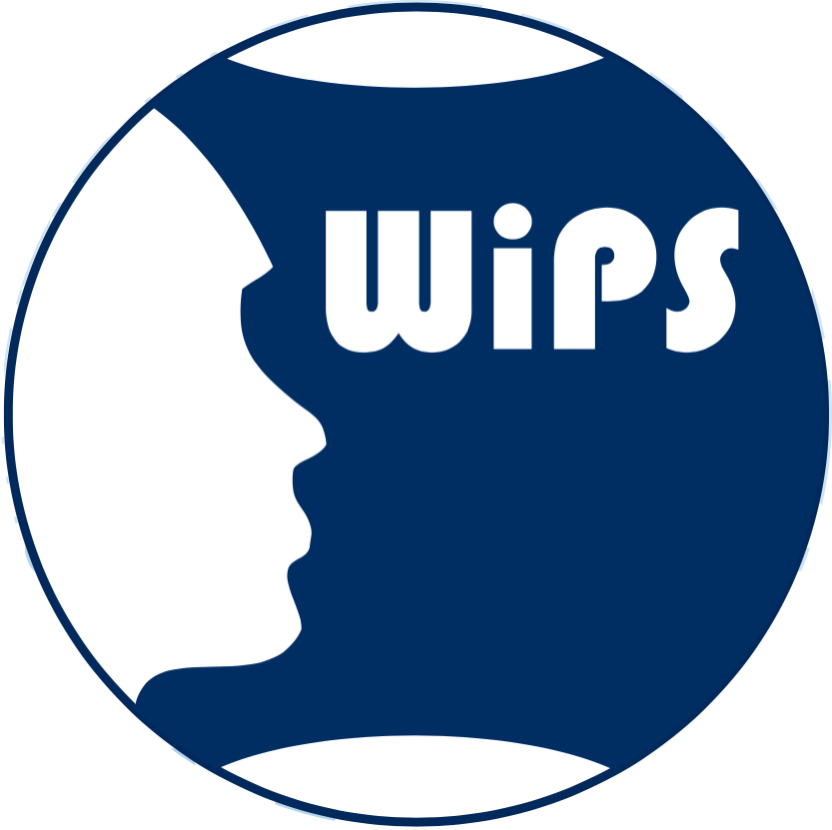Meet 100 Women in Polar Science and Support!
We’re collecting stories from 100 global women in polar employment, both polar science and non-academic polar roles. Check them out here – updated weekly!
Our thanks to the Curtis and Edith Munson Foundation for funding this project, The Ocean Foundation for acting as the US fiscal sponsor, and the Scientific Committee on Antarctic Research (SCAR) for their support.
Want to feature or know a cool woman who should? Contact us!
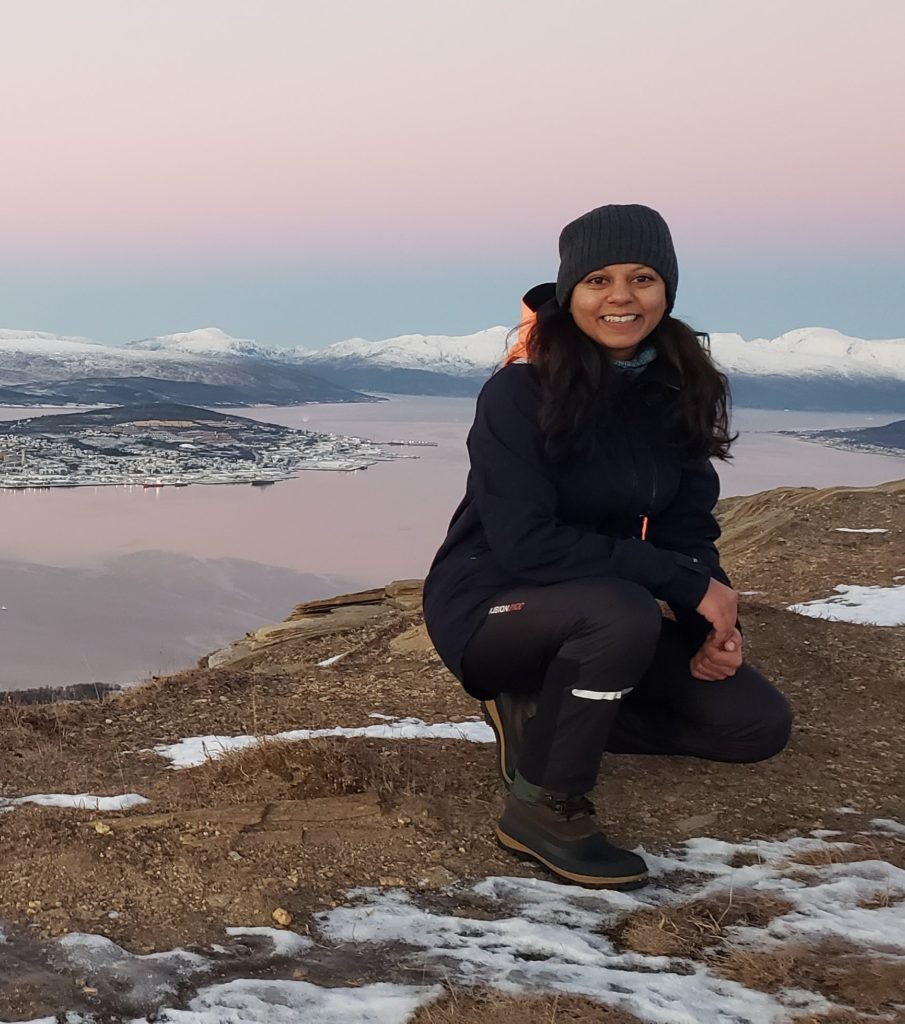
Stephanie Ramsaroop
Discipline: Environmental Management/Marine Mammal Conservation
Age: 37
Nationality: Trinidad and Tobago
Organisation: Freelance consultant, currently on study leave at the University of the Basque Country
Regional focus: Arctic
Social media: Instagram and LinkedIn
What’s the work that you do?
I am a freelance Marine Mammal Observer and I monitor and mitigate for wildlife during surveying activities offshore all around the world. I have been in this field for over 13 years.
In order to to better at my work, I decided to complete a Masters in Marine Environment as an Erasmus Mundus scholarship recipient, here at the University of the Basque Country.
My most memorable work in the Arctic was with Sea Women Expeditons. We conducted Orca behavioral studies during the winter herring run in the Arctic fjords. This experience was nothing less than amazing – with humpback and fin whales also joining in the feeding frenzy. I was truly humbled being in the presence of these magnificent beings.
What keeps you going?
I am passionate about protecting the animals and their homes. Although it may be a difficult job living at sea for long periods of time I like to think of making a difference in the bigger picture. What also keeps me going is the ability to make an impact on other young women, to help support and encourage them to be a part of the marine world as we need more voices to support each other.
What’s your message to the world?
The opportunity for change is out there, we just need to come out of our comfort zone go after it. It starts with us, as we should be the change we want to see in the world. No one will do it for you.
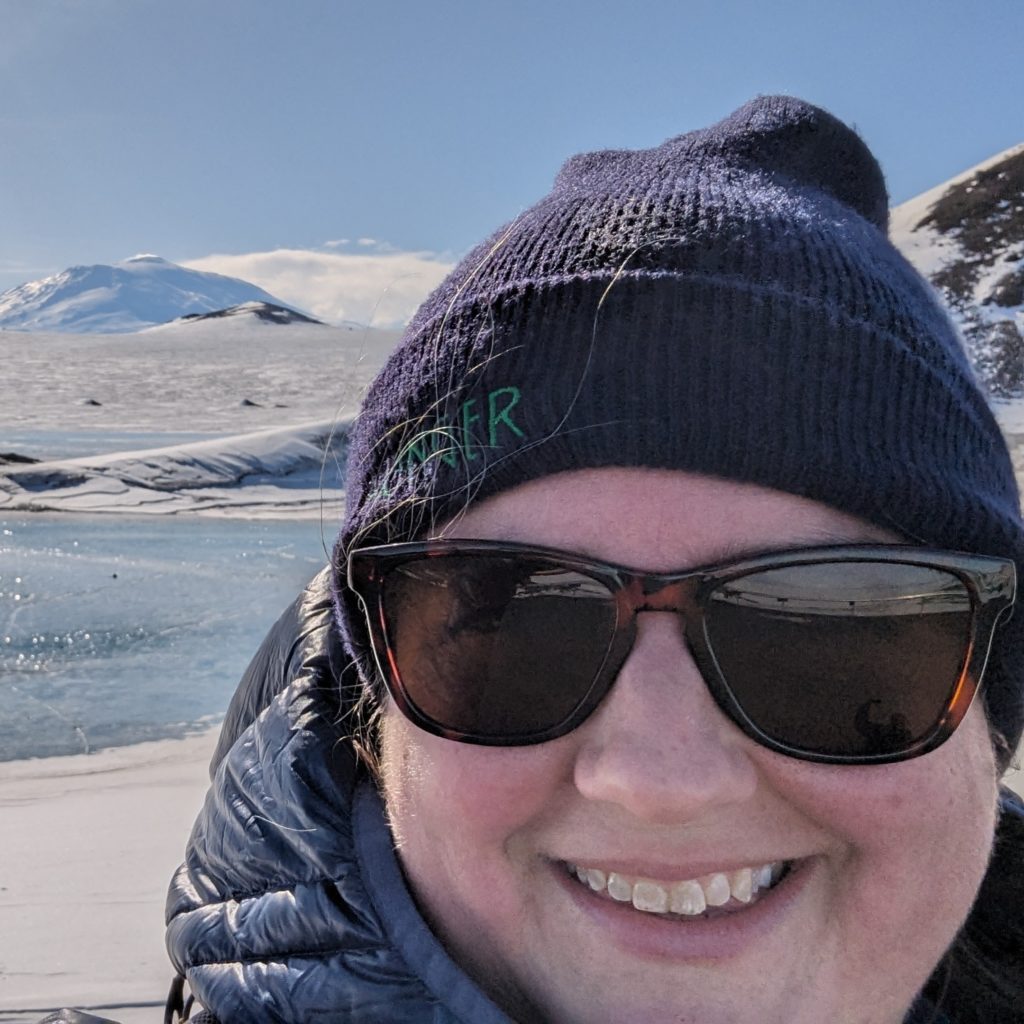
Jennifer Kunze
Discipline: Sous Chef
Age: 52
Nationality: USA
Organisation: GSC
Regional focus: Antarctic
Social media: Facebook
What’s the work that you do?
It ain’t easy cooking for 600-1000 people… But I make sure my team keeps the food hot and ready for when the station is hungry! Frozen food, lack of fresh ingredients, sometimes we run out of spices! It’s a harsh continent, but we keep everyone fed.
What keeps you going?
I love the challenge of problemsolving when you can’t just run out to the grocery store to get more onions to dice! Love adventure and seeing places and things I might never have the opportunity to visit or experience otherwise.
What’s your message to the world?
Never let others determine your limitations. Get out and explore!
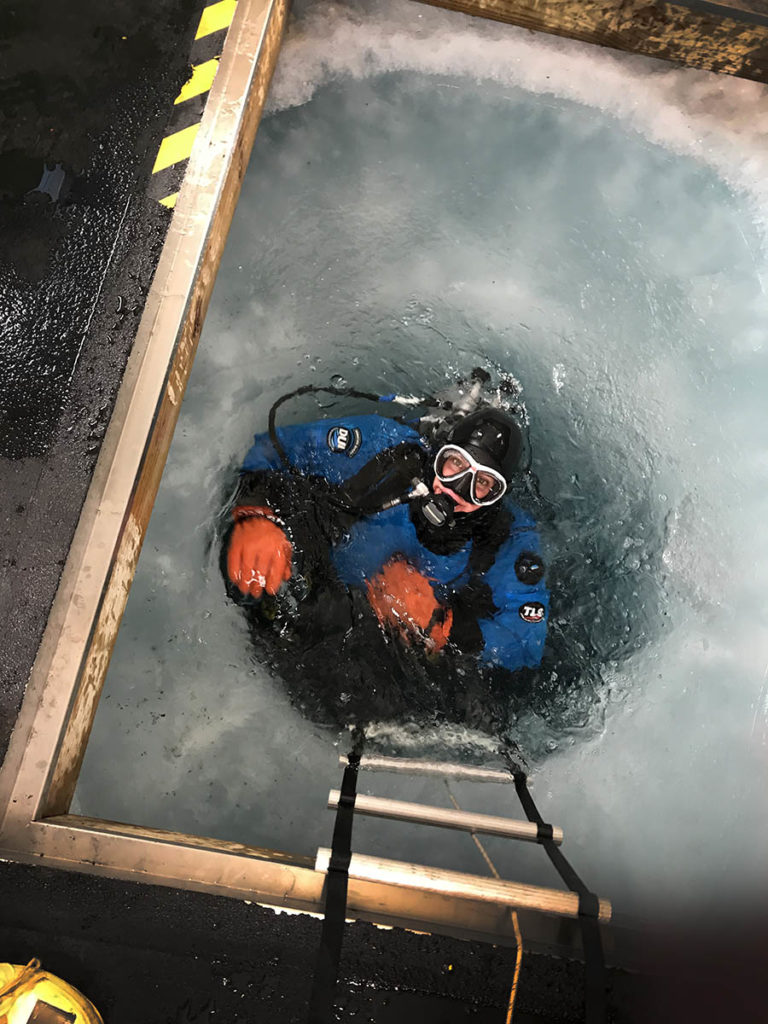
Kirsten Carlson
Discipline: Illustrator, designer, author
Age: 55
Nationality: USA
Organisation: Self-employed
Regional focus: Antarctic
Social media: Instagram and website
What’s the work that you do?
I’m an illustrator with 30 years experience exploring the world as a scientist-artist. Antarctica altered my world view when I was a young scientist diving in the Antarctic and I combined my love for marine ecology with scientific illustration.
I create visual stories about the animal world for diversely educated audiences, from scientific journals to children’s books.
I returned to Antarctica in 2017 as an NSF Antarctic Artist & Writer. I’m co-chair of the Antarctic Artists and Writers Collective; our mission is inspire and educate the public about Antarctica and its scientific exploration through collaborations in the arts.
What keeps you going?
Exploring nature and capturing it on the page is the perfect path for me to share all that I fathom and feel about the ocean’s magnificence and preciousness. I believe that combining science and art helps a person develop an ability to see things with an ever more curious and creative mind and feel connected to our planet. And, what I do gives me the opportunity to share the animals’ stories, since they cannot speak for themselves.
What’s your message to the world?
I love the wisdom passed on through quotes, so I will share one from the first person to take me underwater, virtually, through a tiny black and white television screen:
“To enlarge the human perspective, to build on knowledge for future generations, to identify dangers, and to chart the course to a better world: If these are the goals of the explorer, then everyone—voyager, scientist and citizen, parent and child—is engaged in humanity’s momentous expedition.”
― Jacques-Yves Cousteau, French explorer and the inventor of scuba diving.
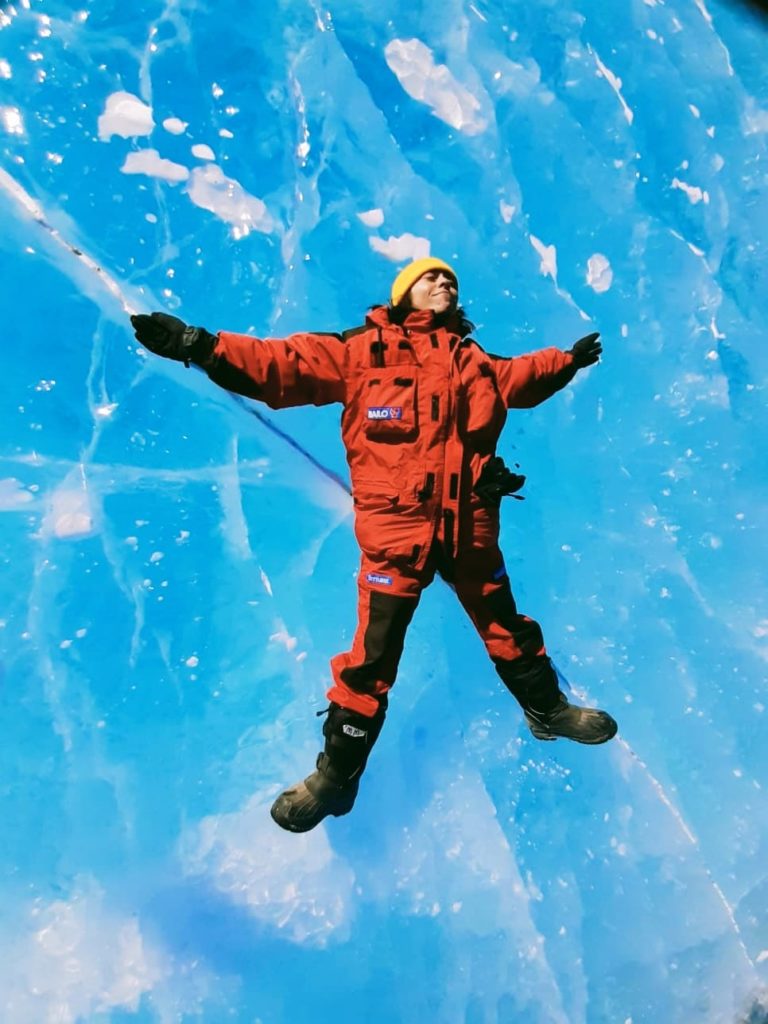
Ing. Milena Massari, PhD
Discipline: Logistics mangement for Italy’s Antarctic Campaign
Age: 37
Nationality: Italy
Organisation: Italian Antarctic Program (PNRA)
Regional focus: Antarctic
Social media: Instagram
What’s the work that you do?
I am a structural engineer working for the logistics section of ENEA-UTA, which is a part of the National Antarctic Reseach Program (PNRA). My contribution to the actuation of the Antarctic campaign involves different aspects: from the management of moving personnel and materials around the globe, over to the handling of Antarctic clothing warehouses (Italy and NZ), supervising contracts for provisions and/or services, to the organization of PNRA training/safety/team building courses for Antarctic ‘newcomers’ before the start of the Campaign and much more. Probably easiest to say: I do everything that is needed to make it work well for good science in Antarctica 🙂
What keeps you going?
I like doing my best to make things happen. Even more than that, I love discovering new horizons and people. I want to believe that research could make a difference for everyone’s future, that we are chasing knowledge for better answers and solutions. We have not ventured on the right path lately, it is time to change consciously, each of us can be part of it.
What’s your message to the world?
Using Bob Marley’s words: ‘Get up, stand up/Stand up for your right/Get up, stand up/ Don’t give up the fight!’ 360° meaning, always gently, that’s the real revolution.
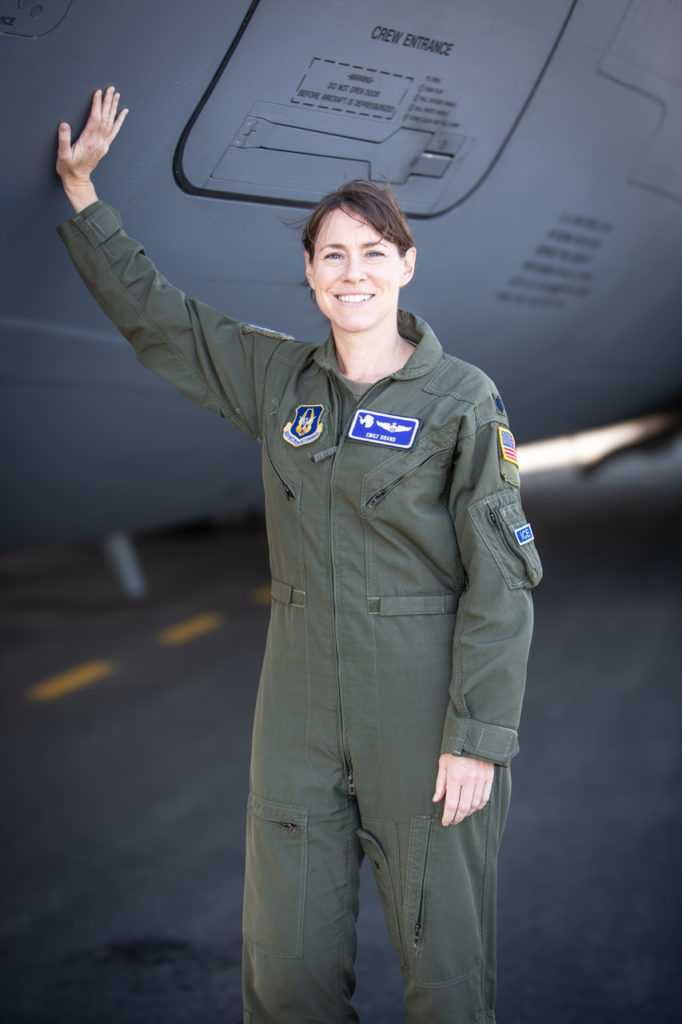
Lt.Col. Emily Brand
Discipline: United States Air Force Reserves C-17A Pilot
Age: 40
Nationality: USA
Organisation: United States Air Force, 446th Airlift Wing
Regional focus: Antarctic
What’s the work that you do?
I fly C-17A Globemaster III cargo aircraft for the United States Air Force. The C-17 is designed for rapid strategic delivery of troops and all types of cargo on a worldwide scale. Our Antarctic program, Operation Deep Freeze, supports the US National Science Foundation’s operations at McMurdo Base on the Ross Island Ice Shelf. We carry personnel and supplies back and forth throughout the summer months, and have the capability to land in the dark winter months using specialized night vision equipment. This year-round capability is important as a lifeline for the personnel living and working at McMurdo.
What keeps you going?
I like the view of the world from the pilot’s seat. I enjoy traveling the globe and experiencing different landscapes, cultures and people. The challenges that come with flying are exciting and humbling. I especially enjoy making a difference and playing an essential role in the various types of missions we accomplish.
What’s your message to the world?
Slow down. Be joyfully receptive to what the world hands you. Relish every moment and opportunity, and have gratitude for each day.
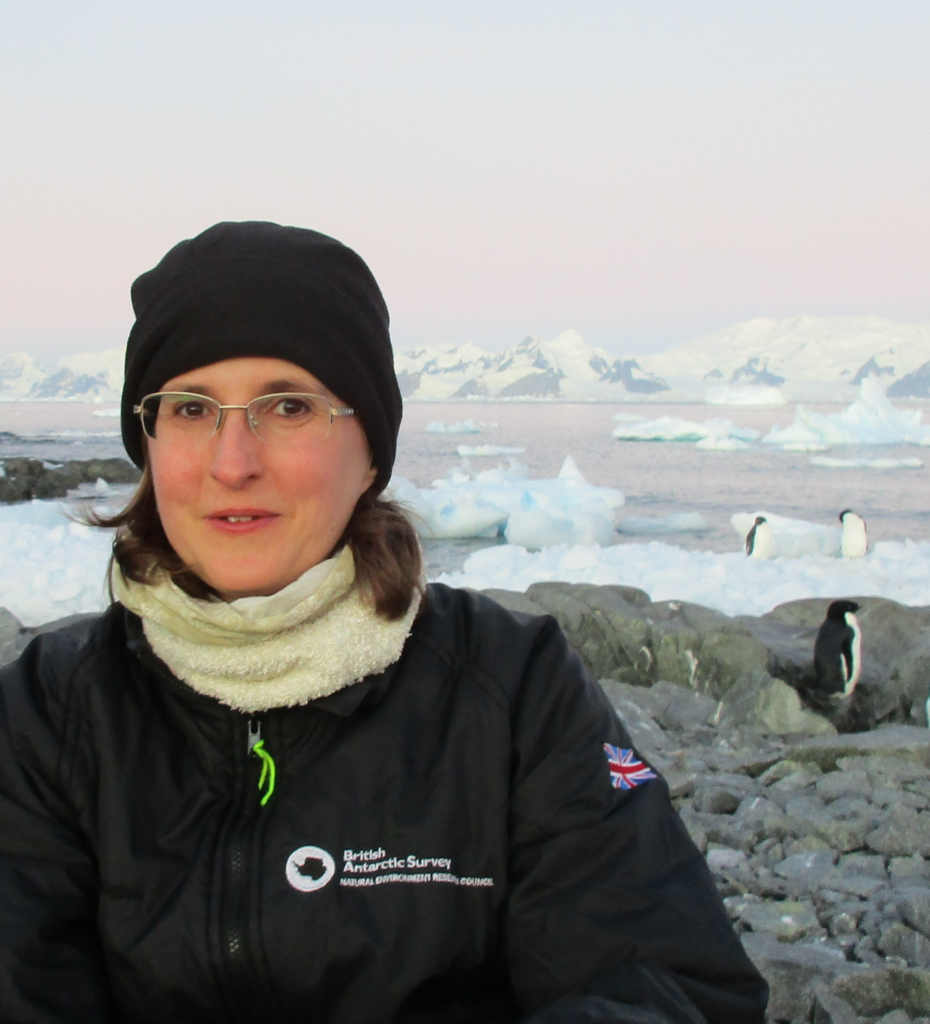
Tracy Moffat-Griffin, PhD
Discipline: Atmospheric physics
Age: 45
Nationality: UK
Organisation: British Antarctic Survey (UK)
Regional focus: Antarctic
Social media: Twitter
What’s the work that you do?
I’m the Science Leader for the Atmosphere, Ice and Climate Team at BAS, we study climate variability and key physical and chemical processes that influence the highly coupled polar atmosphere-ice-ocean system. My personal area of research is the study of atmospheric gravity waves and tides as a dynamical coupling mechanism in the polar regions, to understand their variability and the role they play in driving atmospheric circulation. I am also interested in climate change and extreme weather events in the polar regions plus space weather effects on middle atmosphere circulation.
What keeps you going?
I have always loved science and problem solving, so, for me, my day-to-day research allows me to do what I love! As my career has progressed, I’ve had opportunities to work with a wide range of people on really exciting projects, develop (with our fantastic engineering team) instrumentation and help to deploy them in the Antarctic. I’m still eager to learn new things and expand my scientific knowledge.
What’s your message to the world?
Believe in yourself and don’t listen to people who say you can’t do something just because of your gender! If you believe you can, then go for it!
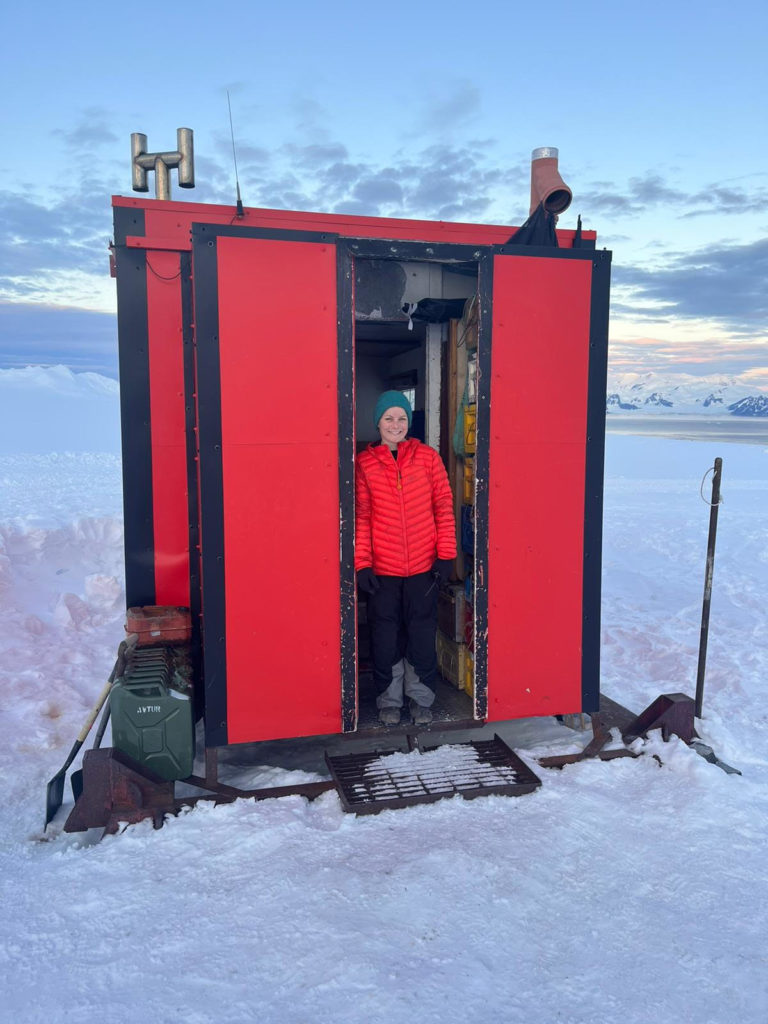
Eva Riehle, MSc
Discipline: Environmental toxicology, polar microbial diversity
Age: 29
Nationality: Germany
Organisation: University of Konstanz (Germany)
Regional focus: Arctic and Antarctic
Social media: Instagram and Twitter
What’s the work that you do?
I am a scientist working primarily on cyanobacteria in polar regions. I study their contribution to microbial mats in the Arctic and Antarctica, which toxins they produce, and how climate change will impact them. Part of my job is to go to remote regions in the Arctic and Antarctica to collect samples and set up experiments. At the university, I do plenty of DNA metabarcoding and bioinformatics to study microbial diversity and mass spectrometry to analyze the presence of cyanotoxins in the environment. I also teach several courses for Bachelor and Master students about ecology in polar regions and the presence and fate of natural toxins.
What keeps you going?
I am working on such an interesting project and get to combine cool research methods with a topic that (generally speaking) concerns almost everyone. My job allowed me to experience far away, remote places and I feel incredibly privileged I get to work in the Arctic and Antarctica. There are new challenges every day, from changing weather conditions to broken equipment, and I love figuring out a creative way to make the science happen. When I am home, I enjoy teaching courses at the university to share my knowledge and inspire other scientists to work on projects they really care about.
What’s your message to the world?
The sense of community I’ve experienced at polar research stations is outstanding, and I think a little bit of that supportive and encouraging environment in everyday “normal life” wouldn’t hurt. Staying in the Arctic and Antarctica also makes you realize again how precious the Earth is and that we must try and protect it as best we can! Climate change is real, it’s fast and has dramatic effects. Lastly, if there is something you really want to do, be brave and dare to dream. It can be daunting at times, but most of the time it is worth it in the end!
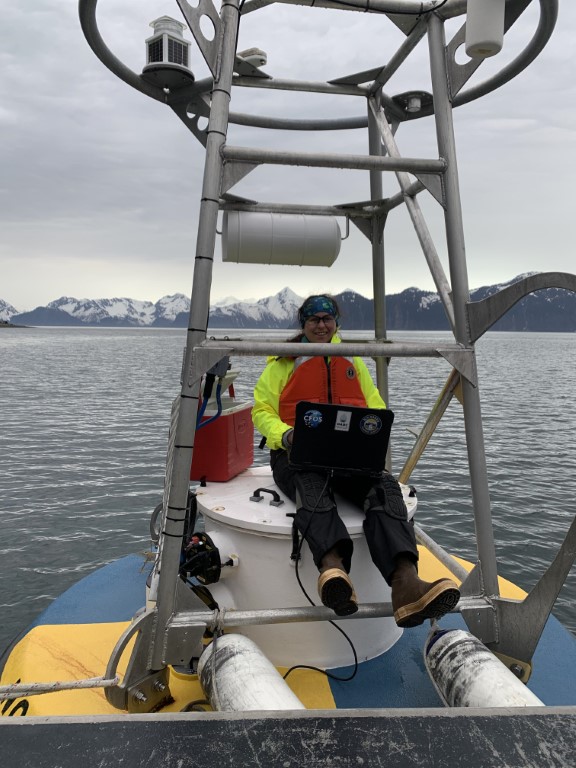
Natalie Monacci, MS
Discipline: Chemical Oceanography
Age: 42
Nationality: USA
Organisation: University of Alaska Fairbanks (USA)
Regional focus: Arctic
Social media: Twitter and website
What’s the work that you do?
I am the director of the Ocean Acidification Research Center (OARC). We observe the marine carbonate system in Alaska’s four large marine ecosystems: Gulf of Alaska, Bering Sea, Chukchi Sea, and Beaufort Sea. We use shipboard surveys, moorings, and remotely operated vehicles to monitor ocean acidification in the Pacific Arctic Region. The OARC is also a recharge center and we receive samples submitted from multiple users to monitor for ocean acidification in Alaska.
What keeps you going?
I was hooked on science when I took my first chemistry class. Then I found oceanography and realized I could do chemistry outside, and even better, at sea. I like the active parts of my job the most: lab work and field work. I have worked other places, but Alaska is a dream. Living and working in a place that is immense is inspiring, there is so much to learn and experience.
What’s your message to the world?
I am a career staff research scientist at a university. These positions are not what administrators are writing newsletters about. The majority of personnel I work with are staff and they are rarely seen in science highlights. I operate with the philosophy that every project requires all sorts of personnel and they are all valuable.
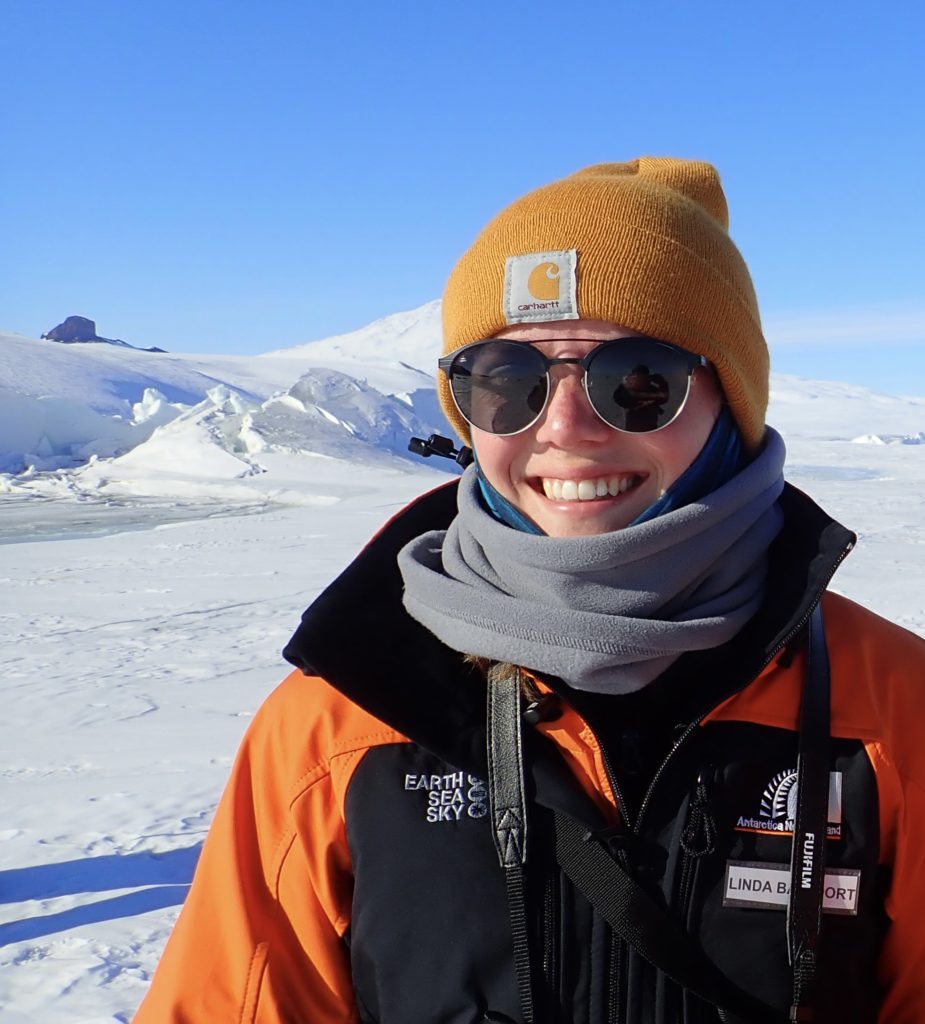
Linda Balfoort, MSc
Discipline: Sedimentology
Age: 25
Nationality: The Netherlands
Organisation: Te Herenga Waka – Victoria University of Wellington; Te Puna Pātiotio – Antarctic Research Centre (New Zealand)
Regional focus: Antarctic
Social media: LinkedIn and Instagram
What’s the work that you do?
In May 2023 I finished my MSc thesis in Antarctic sedimentology. I was privileged enough to go to Antarctica during the 2021/2022 field season where we collected a sediment core from underneath the Ross Ice Shelf. The sedimentology there suggests interaction between subglacial hydrology, subglacial sediments and ice streams. I have since started a PhD project with SWAIS2C (Stability of the West Antarctic Ice Sheet under 2 degrees Celsius warming), where we will attempt to collect a longer sediment core from underneath the Ross Ice Shelf. I am especially interested in the stability of the Antarctic Ice Sheets under future climate change.
What keeps you going?
My passion for the subject, the immense privilege of being able to work in this field, the amazing people I get to work with and the amount I am learning from them. There is also a sense of urgency with my research since it is relevant to climate change research.
What’s your message to the world?
Stay kind, understand that everyone’s brain operates differently, and respect your own brain! One of the hardest lessons I am currently learning is that there are limits to how much I can handle, I will always feel better if I also keep space for fun, relaxing, loved ones and pets.
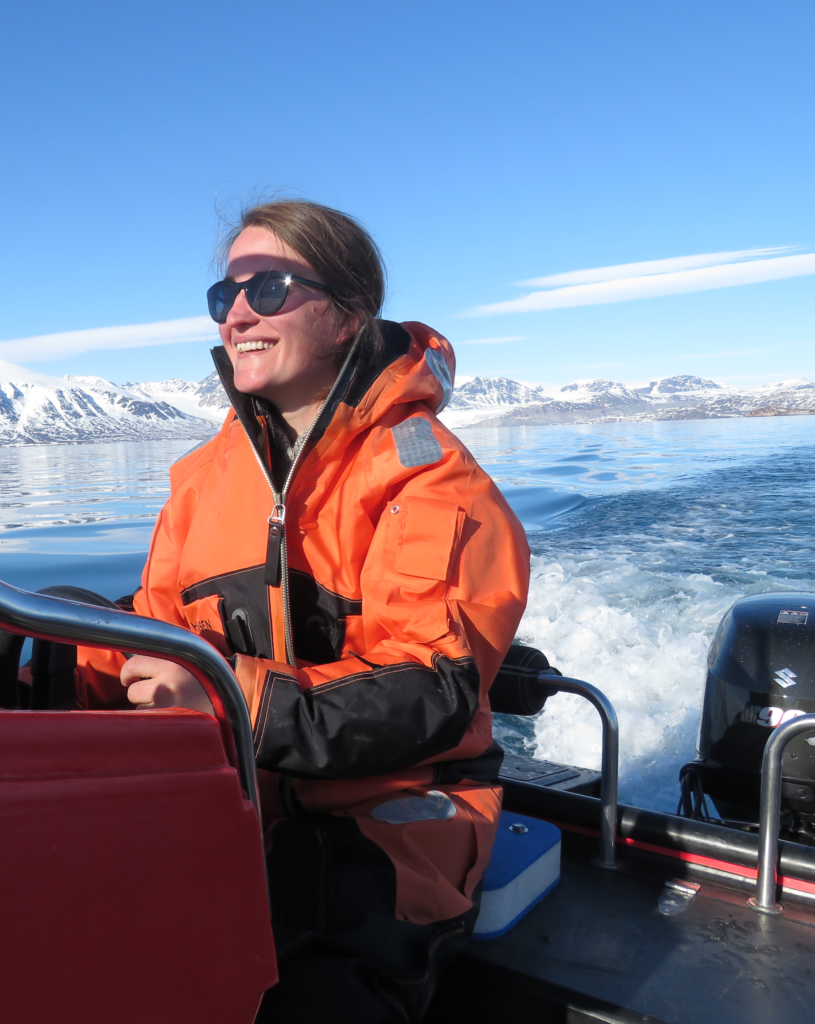
Celine Albert, PhD
Discipline: Ecology, Ecotoxicology
Age: 39
Nationality: France
Organisation: Arktisk Station/Copenhagen University (Denmark)
Regional focus: Arctic
Social media: Website and Twitter
What’s the work that you do?
I am currently the scientific leader of Arctic Station (Copenhagen University), in Qeqertarsuaq, Greenland. I am also a postdoctoral researcher. I study contamination by pollutants in Arctic seabirds, with a special focus on where they get contaminated and how that impacts their survival. This year I also train with the leadership program Homeward Bound.
What keeps you going?
I love science. I love collecting data, working on them and discover new results. I also enjoy very much communicating about it to different kinds of the public (scientists, kids). I am passionate about the Arctic and work to protect it, its communities and environment.
What’s your message to the world?
I often hear that what’s happening in the Arctic is so far away that it doesn’t really matter. This is not true. What happens in the Arctic impacts other regions of the world and what you do in other regions of the world impacts the Arctic. Remember that by protecting your environment, you will protect much more than just your immediate surroundings.
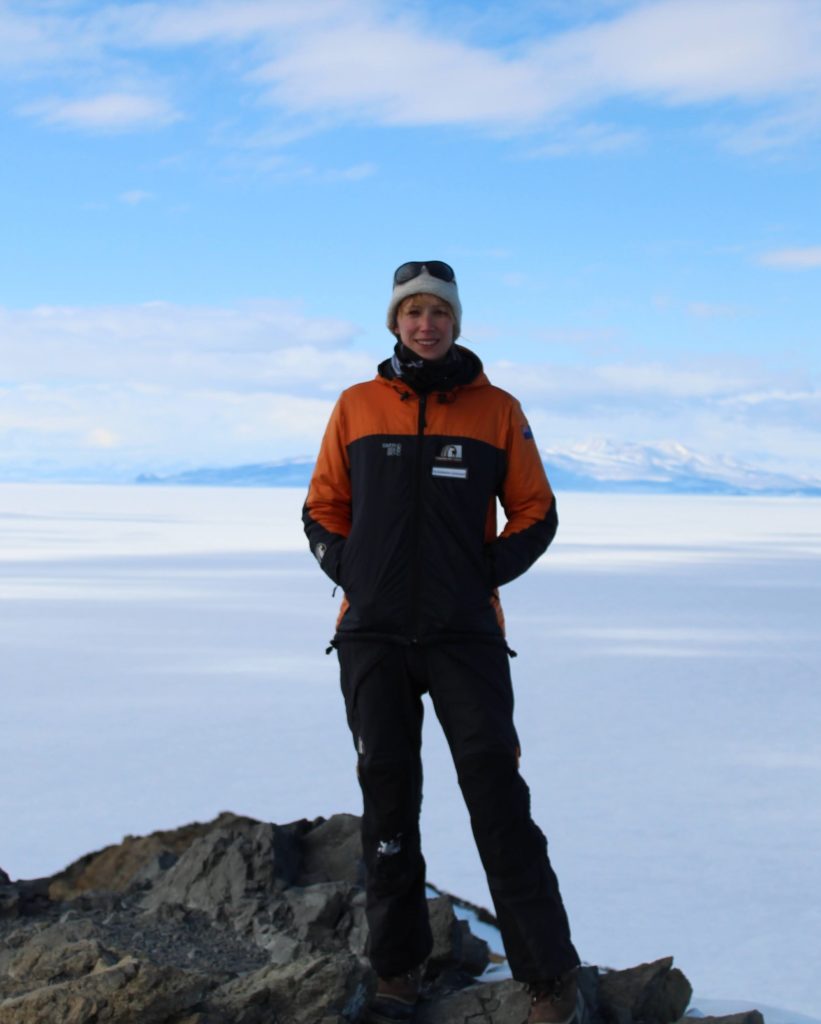
Alex Gossart, PhD
Discipline: Climate modelling
Age: 35
Nationality: Belgium
Organisation: Victoria University of Wellington (New Zealand)
Regional focus: Antarctic
Social media: ResearchGate
What’s the work that you do?
I am a regional climate modeller and use the Polar version of the Weather Research & Forecasting Model (P-WRF) to understand processes and interactions between the atmosphere and the surface of the Antarctic Ice Sheet, with a focus on surface mass balance components such as surface melt, precipitation events, blowing snow, etc. I have also coupled the atmosphere PWRF model to the ocean MITgcm model (with Dr Alena Malyarenko) to study air-ocean and sea ice interactions over the Ross Sea domain, including polynya activity and sea ice extent for the present day.
What keeps you going?
I love to explore processes in Antarctica, by running sensitivity experiments and creating alternative realities (altering the forcing of the model) to investigate the effects on the earth system. I think it is amazing and required to understand the risks of future warming and implications for the Antarctic Ice sheet and its contribution to gobal sea level rise.
What’s your message to the world?
I can create alternative realities – I wish I could actually have an impact on where the world is heading.
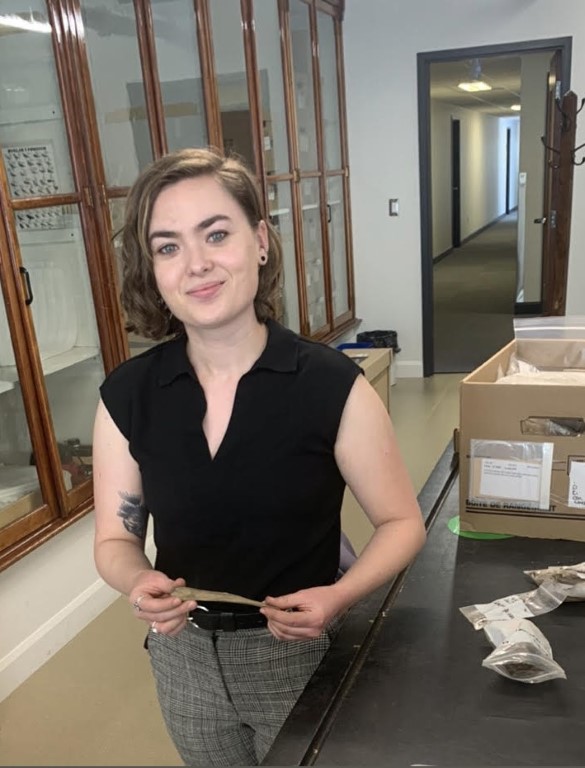
Alexandra Derian, MA
Discipline: Archaeology, environmental science
Age: 26
Nationality: Canada
Organisation: Trent University (Canada)
Regional focus: Arctic
Social media: Twitter
What’s the work that you do?
I am a PhD student studying arctic fox diet and ecology in response to Inuit and Paleo-Inuit hunting practices over the past 2,000 years. I am a zooarchaeologist and stable isotope scientist. I specialize in identifying animal skeletal remains and determining the stable isotopic and elemental composition of their bone collagen.
What keeps you going?
I love my work because I get to uncover what happened in the past. It is an amazing feeling to hold in my hands a bone that is hundreds or thousands of years old, and tell the story of the animal so long after its life.
What’s your message to the world?
Zooarchaeology and stable isotope analysis are powerful tools that can uncover knowledge of the ways in which humans and animals shared space and time in the past. I feel very fortunate to work alongside people who have a shared passion for learning from the past to work toward a more sustainable, equitable future.
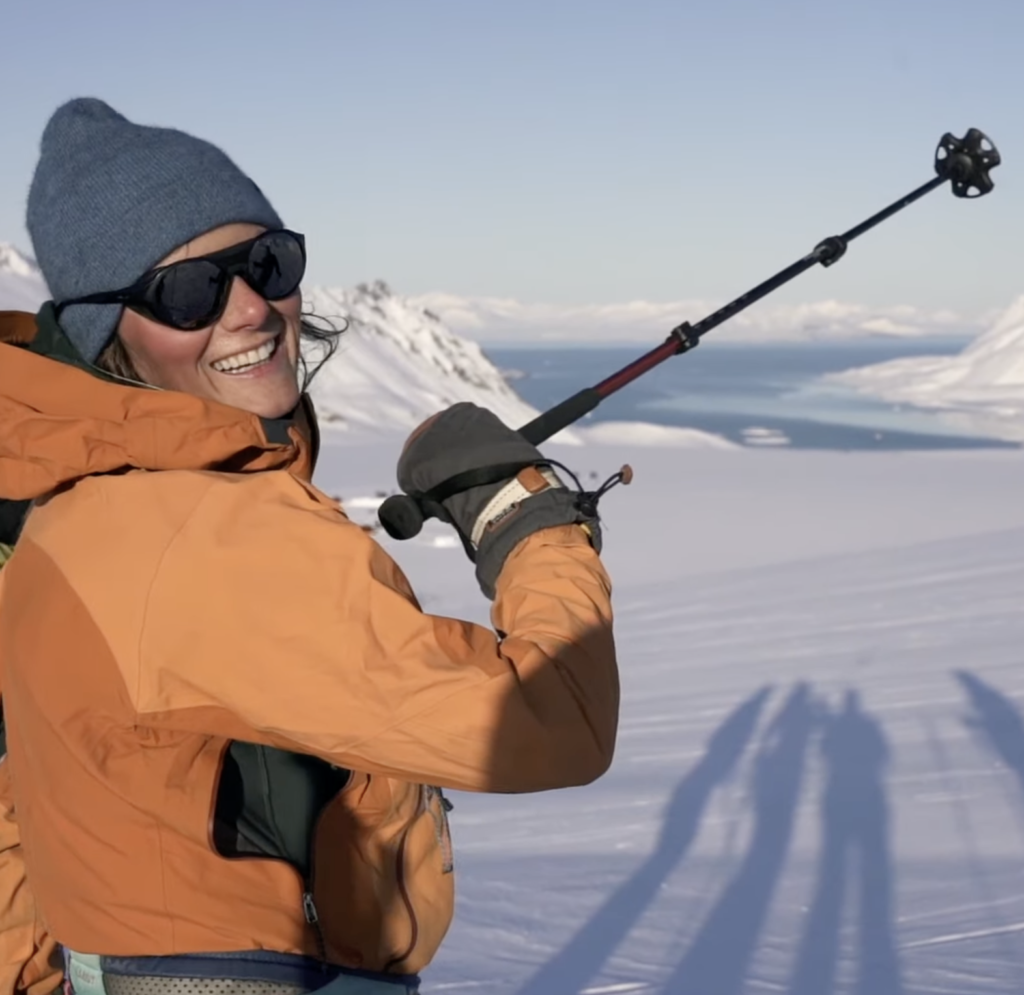
Barbara Olga Hild
Discipline: Risk management and safety competence for Arctic field guides
Age: 33
Nationality: Poland
Organisation: University of Iceland and Campus Kujalleq (Iceland; Greenland)
Regional focus: Arctic
Social media: LinkedIn and website
What’s the work that you do?
I am finishing my PhD studying risk management and safety competence development related to leading trips in the Arctic harsh and remote environment. I am interested in understanding the relationship between program curriculum design, teaching methods and students’ experiences in safety competence development among adventure tour guides working in Svalbard, Iceland and Greenland. I am managing a cross-industrial project bridging academia, tourism, and education focusing on knowledge co-creation in field of safety, education and tourism (www.articguideeducation.com). I spent the majority of the research doing participant observation in guides’ education in Svalbard and Greenland, spending more than 120 days in the field. Currently I am a teacher and program coordinator for an Adventure Guiding Program in Greenland. I am a certified Arctic Nature Guide experienced in leading groups in both polar regions.
What keeps you going?
I worked as an outdoor educator in China, Mexico, Iceland, South Korea and USA before I went into Arctic guiding, which made me aware of cultural differences and gave me the ability to learn from our differences. As a guide, researcher and teacher I feel privileged to work with various stakeholders. I love meeting new people and learning about their ways of living, struggles, but also strategies to make a contribution to a better world. I still believe that we can create a better world together and I hope my research will contribute to that, as incorporates the collective knowledge of everyone I met along the way.
And I have the most beautiful “office” in the world – the wilderness of the Arctic!
What’s your message to the world?
As tourism and education are strongly affected by decision-makers, I am working with the motto, “nothing about us without us”, working towards visibility and inclusion of adventure guides in the policy-making process. Guides are the ones on the ground, they know what it takes to be out there (no matter the weather!), they share the unique, beautiful but often harsh environment with visitors. They represent the companies vision, deal with guests’ expectations, and their risk management is a crucial aspect of tourism development and marketing. By listening to what they have to say about their work we can learn not only about tourism, but also their passion for protecting and sharing the polar environment.
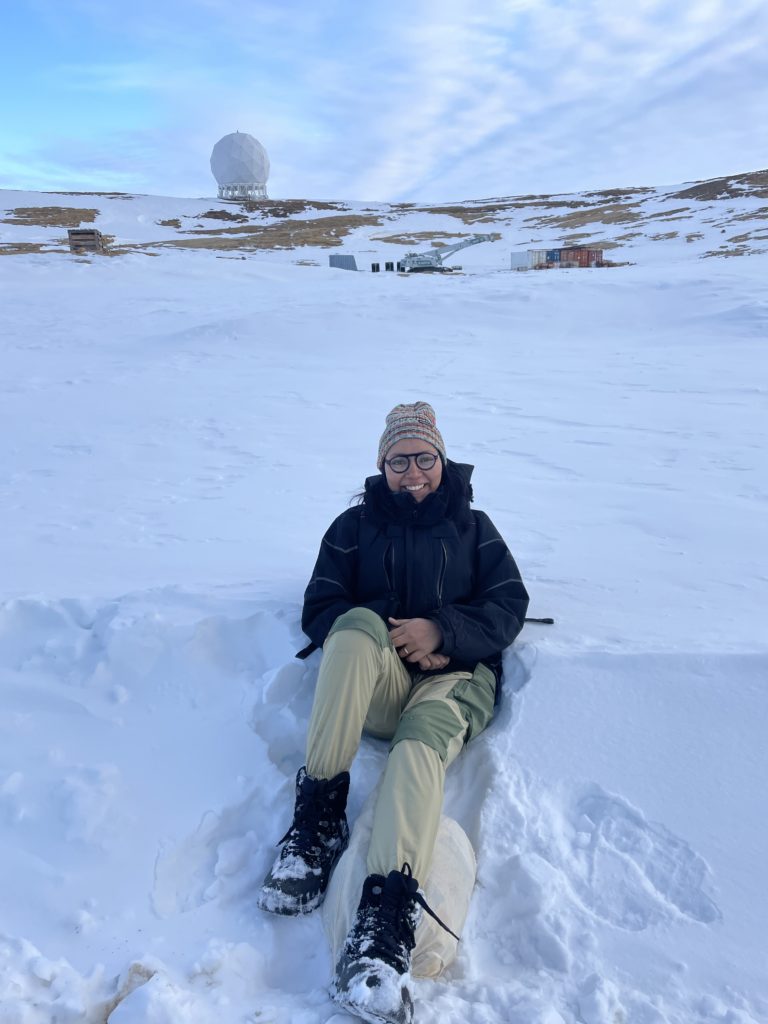
Rashmi Gupta, PhD
Discipline: Geology
Age: 28
Nationality: India
Organisation: Banaras Hindu University (India)
Regional focus: Antarctic
Social media: Instagram
What’s the work that you do?
For my PhD, I investigated glaciomarine sediments in Prydz Bay, East Antarctica, hoping to unveil the origin of these sediments through diverse methodologies like heavy mineral analysis, diamictite petrography, sedimentary geochemistry, and monazite and zircon geochronology. The aim was to learn more about the enigmatic subglacial geology of East Antarctica, a region veiled by extensive ice cover.
During my PhD, I had the remarkable opportunity to partake in the 41st (2021–22) and 42nd (2022–23) Indian Scientific Expeditions to Antarctica. In these expeditions, I conducted fieldwork along the Amery Ice Shelf in East Antarctica, collecting moraines, erratics, ice-rafted debris, from the mouth of glaciers and sediment samples from within ice sheets. These invaluable specimens hold the potential to significantly advance our understanding of the concealed subglacial geology of otherwise inaccessible terrains.
What keeps you going?
The allure of Antarctica lies in its raw and challenging environment, a place where every moment is a test of endurance and discovery. What keeps me going is the unquenchable curiosity to unveil the secrets hidden beneath the icy expanse. The thrill of facing extreme conditions and the privilege of contributing to understanding Earth’s history motivates me. The pristine landscapes, the adrenaline of fieldwork, and the prospect of uncovering geological mysteries are my driving forces. In Antarctica, I find purpose, passion, and the chance to make a tangible impact on our understanding of the planet’s past and its future.
What’s your message to the world?
Antarctica was a dream, a place I yearned to explore. When the chance came, words fell short to describe my elation. I want to convey: Don’t let being a woman hinder you. Chase your dreams, work relentlessly. My message: Embrace the unknown; gender should never be a barrier. Pursue passions fearlessly. My work matters as it unveils Earth’s secrets. Polar realms teach resilience, unity, and the magic of discovery. So, my message to the world: Embrace dreams, overcome odds, and let your spirit soar in the polar winds.
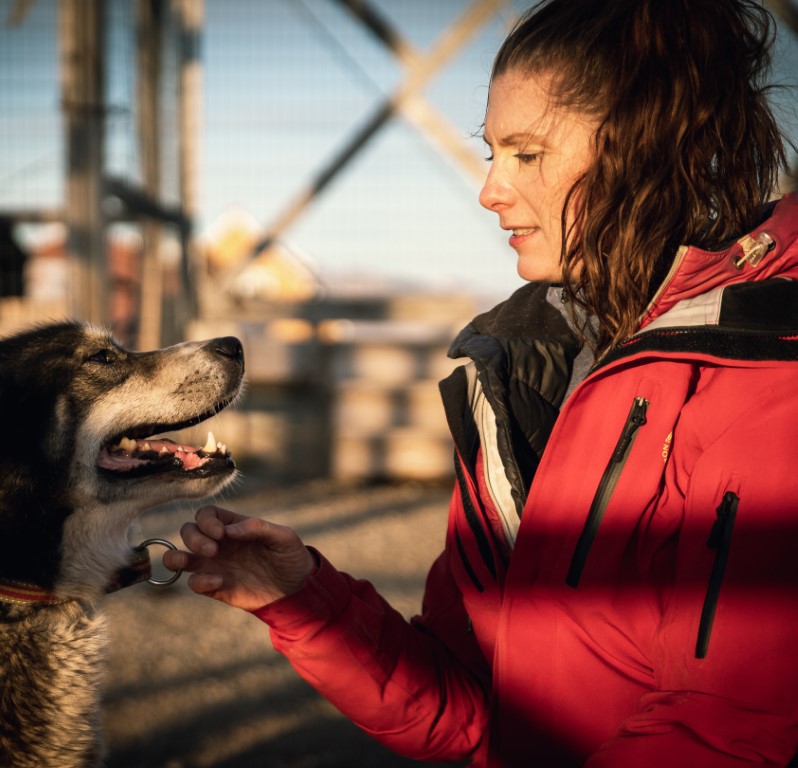
Ingrid Kjestad, MSc
Discipline: Research Coordinator
Age: 36
Nationality: Norway
Organisation: The Norwegian Polar Institute (Norway)
Regional focus: Arctic
Social media: Facebook and Website
What’s the work that you do?
My central tasks are linked to the implementation of the research strategy for Ny-Ålesund. This means, among other things, having a good overview of and close professional contact with visiting research groups, as well as good communication with the management of the research flagships in Ny-Ålesund. I also promote cooperation and coordination with the aim of increasing the quality of research by facilitating digital seminars, manage the GiS-system for research instruments/study sites, run the webpage for Ny-Ålesund research station, and do communication work about the activities in Ny-Ålesund. Together with the manager of The Norwegian Polar Institute in Ny-Ålesund, I also participate in the hosting of national and international research groups and official visits that are coming to see NPI in Ny-Ålesund Research Station.
What keeps you going?
I have been fascinated by the Arctic for over 10 years, from my first summer job in Ny-Ålesund until now, halfway into a two-year contract for the Norwegian Polar Institute. What I like about my job is that I get to do the two things I find most rewarding in a job – to work within a subject I personally burn for, and to be able to work with people. As a research coordinator I get to do this, facilitating for arctic environmental science for visiting researchers to Ny-Ålesund Research Station. I also get to live in the Arctic! In incredible surroundings with glaciers on every corner and wildlife, I get to enjoy the fantastic environment with people within Ny-Ålesund Research Station.
What’s your message to the world?
Take care of the nature and people around you!
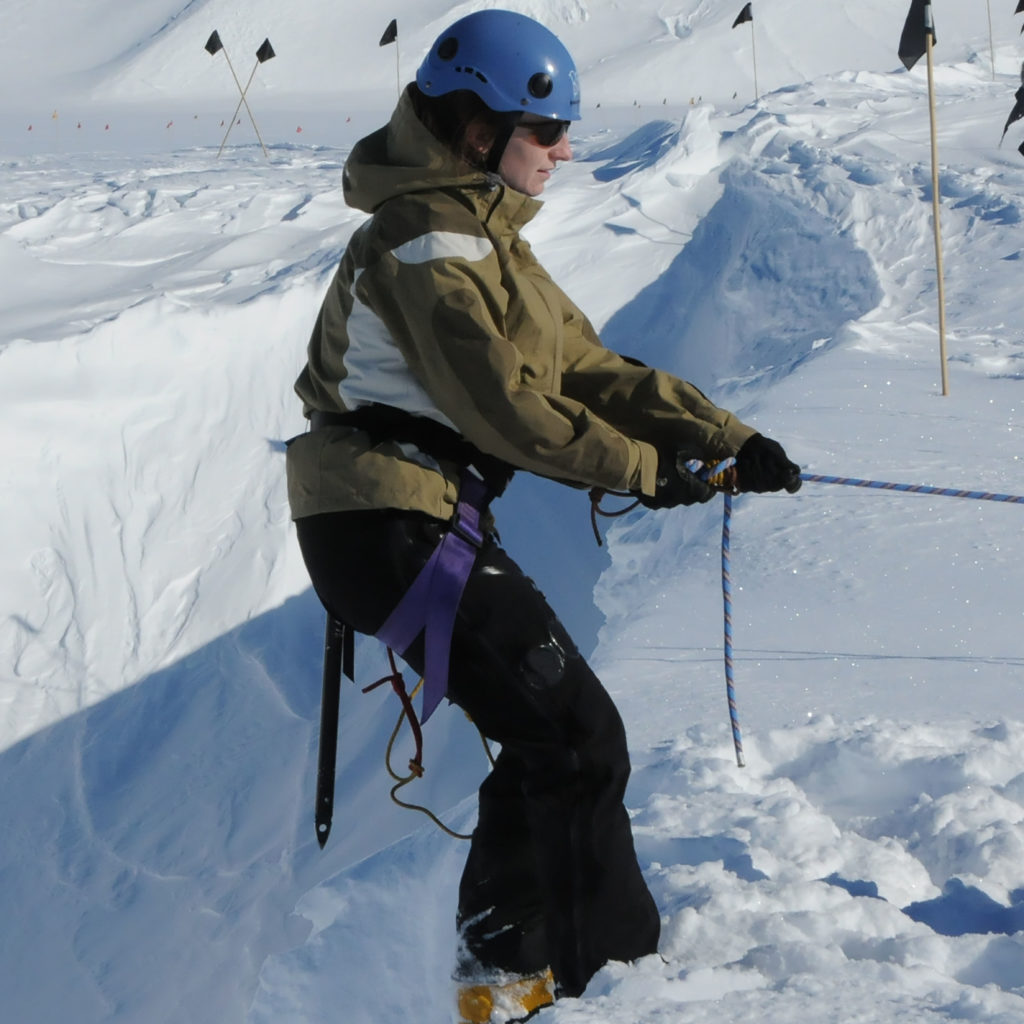
Sarah Child, PhD
Discipline: Observational glaciology
Age: 37
Nationality: USA
Organisation: CIRES University of Colorado, Boulder (USA)
Regional focus: Arctic and Antarctica
What’s the work that you do?
I use historical datasets to better understand changes in glacier dynamics through expanded temporal scales. I primarily use analog aerial photography to generate historical glacier surface elevations using structure-from-motion photogrammetry. My results are used with numerical models to assess the evolution of stress regimes acting on outlet glaciers for the past 50-80 years.
What keeps you going?
I find glacier dynamics fascinating and using remote sensing techniques to assess those dynamics feels like solving a puzzle. I spend hours analyzing imagery of glaciers; staring at beautiful imagery for as long as I do is a close second to fieldwork.
What’s your message to the world?
Research into climate-related studies is more important than ever and it’s a really exciting time to see all of the work being done in Antarctica and Greenland showcasing new glaciological findings and techniques for studying glaciers.
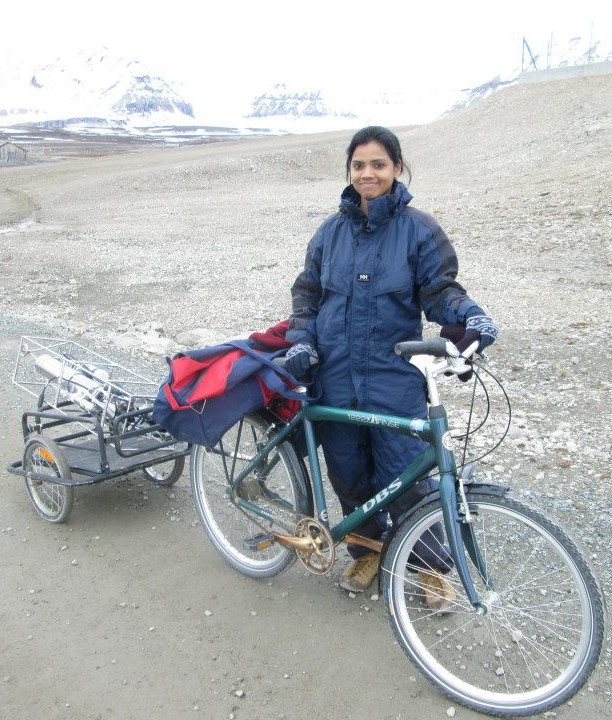
Divya David T, MSc
Discipline: Physical Oceanography
Age: 38
Nationality: India
Organisation: National Centre for Polar and Ocean Research (India)
Regional focus: Arctic
Social media: Website and ResearchGate
What’s the work that you do?
I work on the ongoing variations in Arctic Ocean hydrography and biogeochemistry, quantifying them, and delineating the reasons for the different temporal and spatial scale changes through observations and modelling. Ultimately, I try to understand the connections between these variabilities and low latitudes. Presently, my work focus is the role of Atlantic waters in the changes happening in the Norwegian Arctic Ocean, including the Svalbard fjords. I also try to understand the role of freshwater from the glacial melting in ocean circulation and other associated processes. These can further help to decipher the changes in the dense water formation in the Arctic Ocean.
What keeps you going?
An undying quest and intuition to decipher the mysteries, finding out what happens around me, from the perspective of the dying white polar world. With a load of optimism, the knowledge I find can bring out changes in the world, even if small-scale, drives me towards my goal.
What’s your message to the world?
With the seasonal contrasts and the geographical distances between them and other places, the role of the poles for the climate and weather show how inseparably and interwoven everything around is. It teaches me to accept contrasting facets of my life and acknowledge the necessity of such balance on lives. Thus, polar research shows me interesting aspects of nature’s behaviour and helps impart them in my life.
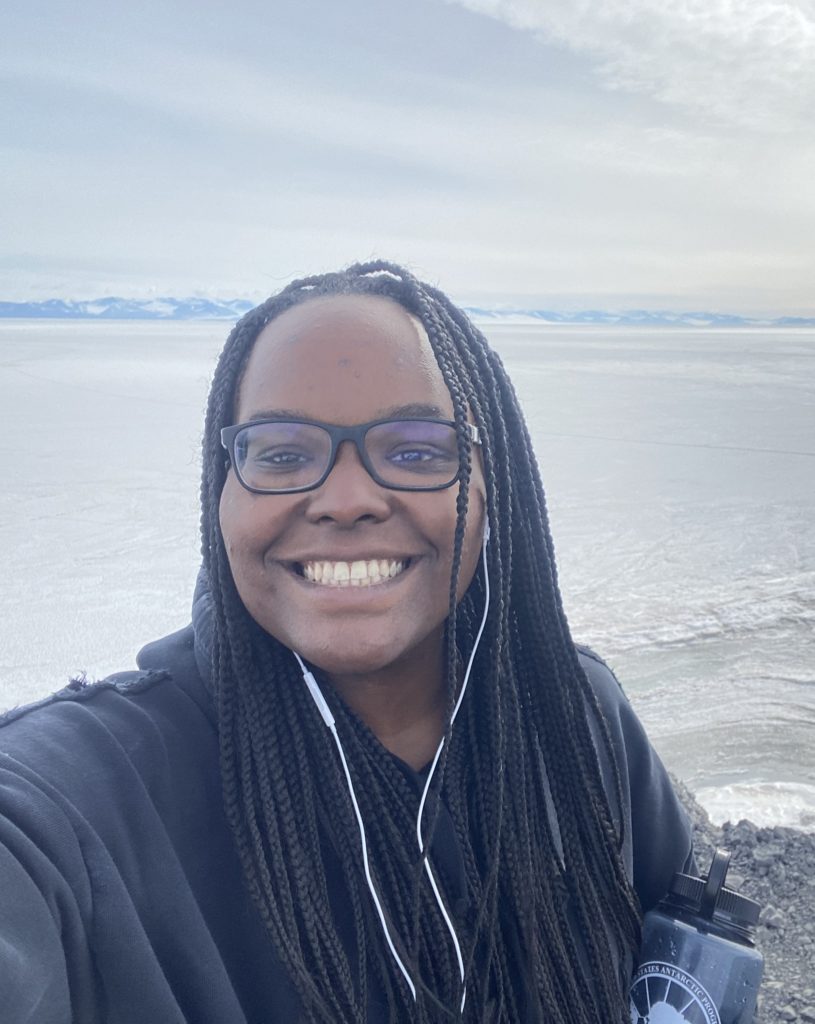
Jessica Johnson, BA
Discipline: Glacial Geomorphology; Multidimensional Neuroimaging; Aerospace Medicine
Age: 23
Nationality: USA
Organisation: US Antarctic Program; National Institutes of Health/NIH (USA)
Regional focus: Antarctic
Social media: LinkedIn and ResearchGate
What’s the work that you do?
I just completed a field season in Antarctica mapping subsurface glacial flow and organic matter content in McMurdo Dry Valleys’ water tracks. I am also currently a research fellow at the National Institutes of Health, using multidimensional diffusion MRI to detect small-scale neurodegeneration in aging.
What keeps you going?
The idea of prolonging human health in space through Aerospace Medicine is infinitely intriguing. Medical advancements in space have had enormous, positive impacts on earthly disorders as well. As a proponent of interdisciplinary work, I love when entirely different disciplines come together to exact meaningful change on society. I am always looking for ways to connect planetary science and medical research to sustain our ability to advance further into the cosmos and terrestrially.
What’s your message to the world?
So long as you enjoy what you do, find purpose in what you do, it does not matter who understands your trajectory. Do what you must and stay steadfast; the right people will come along with you.
If I had listened to the negativity, I would not have gone to Antarctica for planetary science research in the middle of my NIH fellowship this past January.
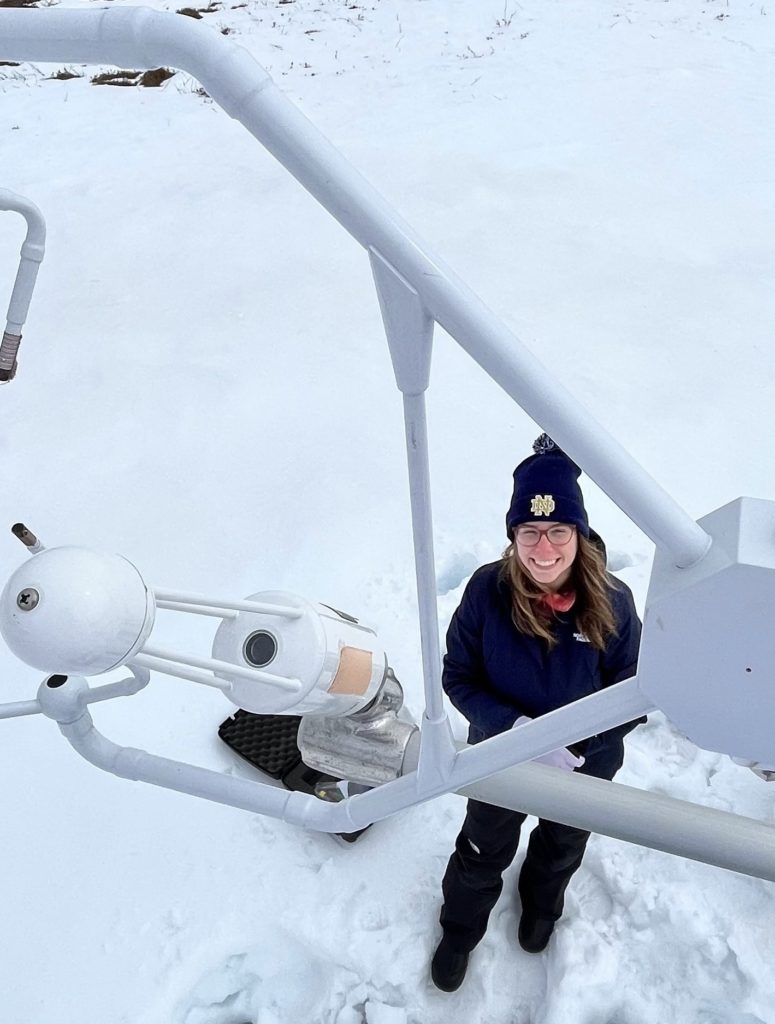
Rachel Badzioch
Discipline: Wildfire ecology, remote sensing
Age: 23
Nationality: Canada
Organisation: University of Notre Dame (USA)
Regional focus: Arctic
Social media: LinkedIn and Twitter
What’s the work that you do?
I am a PhD student at the University of Notre Dame studying the ecological impacts of wildfires on tundra in northern Alaska. I am interested in how carbon stocks are recovered after carbon is lost from burning tundra, and how post-fire changes in vegetation community, biogeochemistry, and microtopography affect carbon recovery. I approach these questions by combining in situ measurements from sites in Alaska with a burn history, eddy covariance data, and satellite and airborne remote sensing data.
What keeps you going?
I love that I get to conduct fieldwork in the Arctic and learn about tundra ecosystems firsthand! As the Arctic changes rapidly due to climate change and fires that are increasing in frequency and severity, there is a great need to understand how the region is responding to these unprecedented environmental changes. I am motivated by the opportunity to study an ecosystem that is so important, and I am grateful that my work involves meeting fantastic scientists, traveling to places that not many people get to experience, and sharing what I learn.
What’s your message to the world?
Our world is quickly changing and there is so much we need to learn about it! With enough curiosity and creativity, anyone can be a scientist and contribute pieces of understanding to the most complex puzzle ever, and hopefully, all of the collective pieces can make a difference.
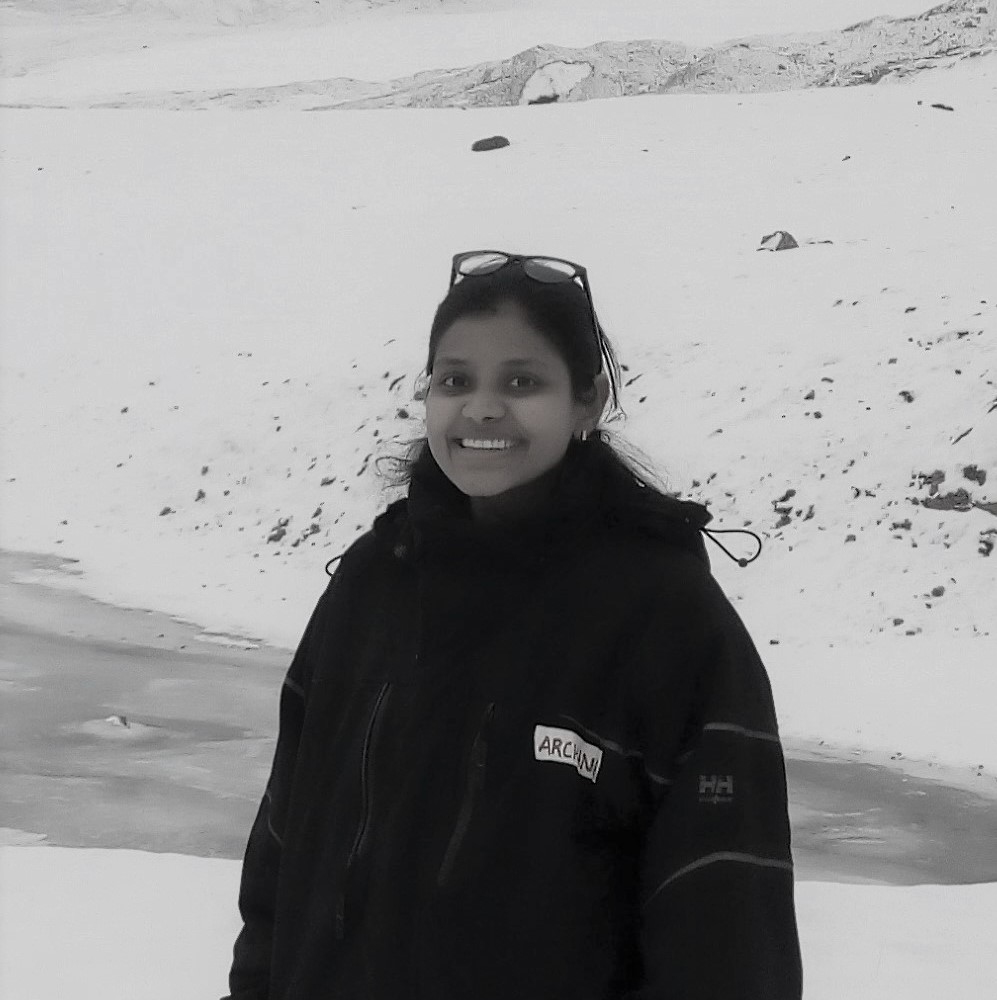
Archana Singh, MSc
Discipline: Biogeochemistry
Age: 32
Nationality: India
Organisation: National Center for Polar and Ocean Research (India)
Regional focus: Antarctic
Social media: Twitter
What’s the work that you do?
I have worked on varied topics related to polar sciences at NCPOR, from cold adaptation of pigmented Arctic bacteria over pigments as organic biomarkers in Arctic sediments to phytoplankton bloom phenology at an Arctic fjord. Working in these varied fields helped in acquainting myself with Polar Regions and their biogeochemistry. Now I am developing expertise in marine organic geochemistry and biogeochemistry. I work with organic biomolecules: carbohydrates, proteins, lipids, pigments, polyphenols, etc. As the basis of life, these molecules hold the key to the understanding of biogeochemical cycles and associated processes. I have also been involved in the logistical and managerial tasks related to polar research expeditions. I have represented India at various international committees, working groups and task forces.
What keeps you going?
Though entering into polar research was accidental for me, I love working in the polar regions. I am a super-active field person and love going on expeditions and working in the field. And for those precious and pristine samples, I love experimenting and working in the lab. My love for both of these things keeps me going despite all the challenges that also exist.
What’s your message to the world?
Be yourself. Sometimes it is difficult, sometimes it makes you an outlier and sometimes it may be useless, but it is original. And there is no substitute for originality. It is easy to find copies, but originals are rare.
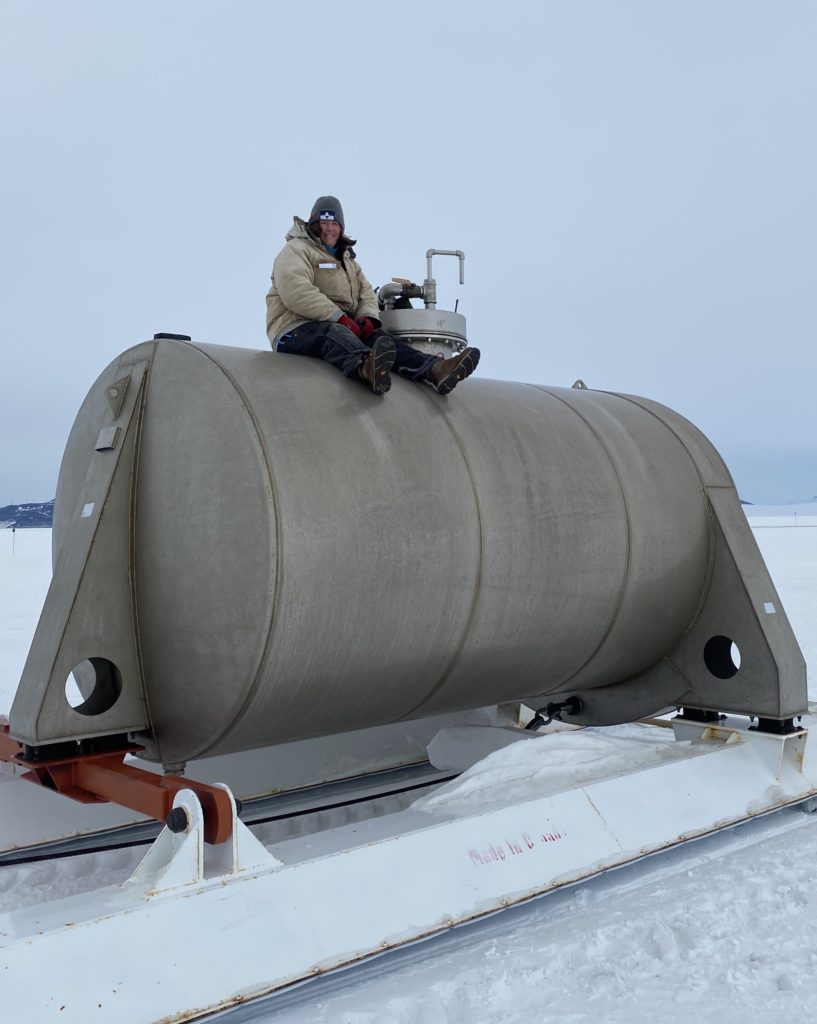
Jennifer DuBois, MSc
Discipline: Fuel operations
Age: 43
Nationality: USA
Organisation: United States Antarctic Program (USA)
Regional focus: Antarctic
Social media: LinkedIn
What’s the work that you do?
I work in the fuels department at McMurdo Station. We make sure all the tanks on station are filled, so we have heat and power. We operate fuel delivery vehicles and get around to most all the buildings on station and out to the airfield every week. In summer we fuel planes and the South Pole traverse and fill fuel drums for caches and field camps. We also make sure vehicles have access to a fueling station.
What keeps you going?
I love being an integral part of keeping the station running and the challenge of being outside all the time, even in winter. I love the inclusive community on station. I like to host events. I spend my free time working on developing artistic skills. I like to share my skills with friends and hope it helps make people’s space on station brighter and homier.
What’s your message to the world?
It can be an intimidating thing to change your whole life to go on new adventures, but it’s worthwhile: you may meet amazing people and see wonderful places.
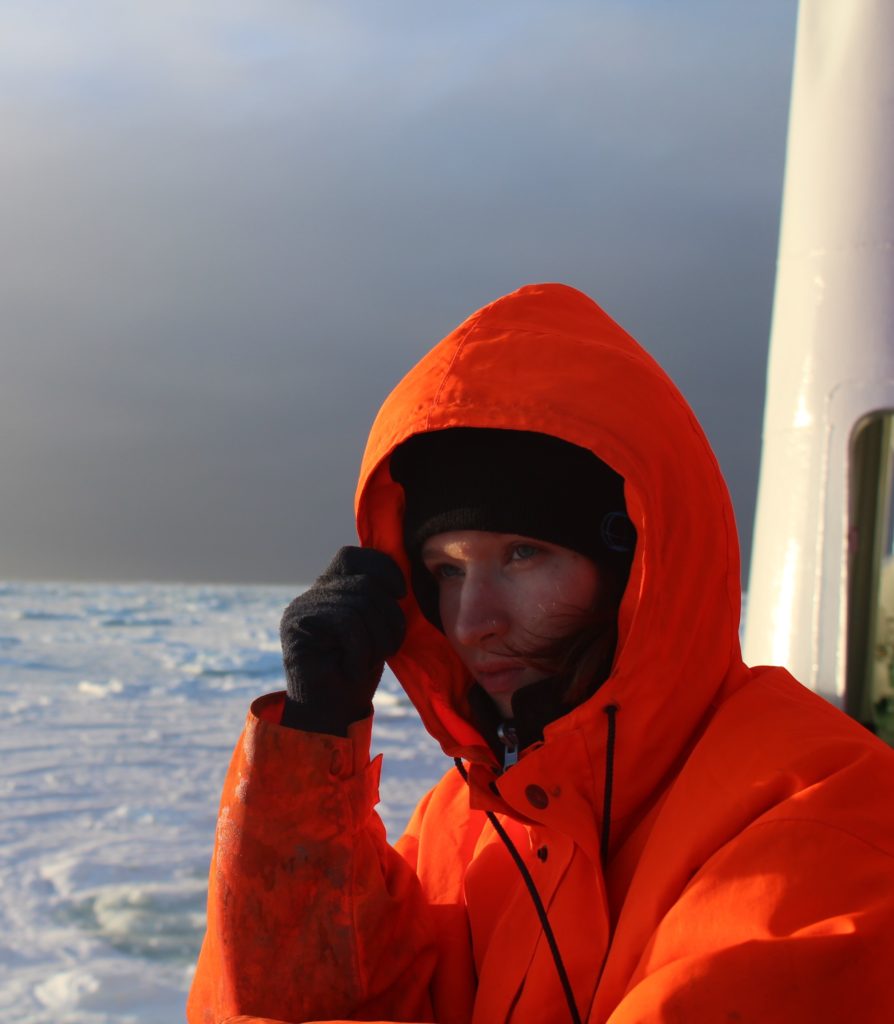
Elena Popova
Discipline: Marine geology
Age: 28
Nationality: Russia
Organisation: VNIIOceangeologia (Russia)
Regional focus: Arctic
Social media: Instagram
What’s the work that you do?
I work with sediments from the Arctic Ocean, both Eurasian shelf seas and the central part. My work covers several aspects: I create lithological maps, study ice rafted debris composition to reconstruct the last deglaciation conditions, and also use grain size distribution as a paleocurrent proxy. Recently I returned from a 7-months long drifting expedition in the Central Arctic where I performed lithological and petrographic work.
What keeps you going?
Fieldwork is a very attractive aspect of a marine geologist’s work in the Arctic because it is a unique experience. Also, telling people about our research, both the process and the results, is just as important as I get to witness the interest of a wider audience in my work. I believe it is beneficial to be open and to share about our work. Polar research and its results should be accessible.
What’s your message to the world?
Enjoy and analyze. Peace!
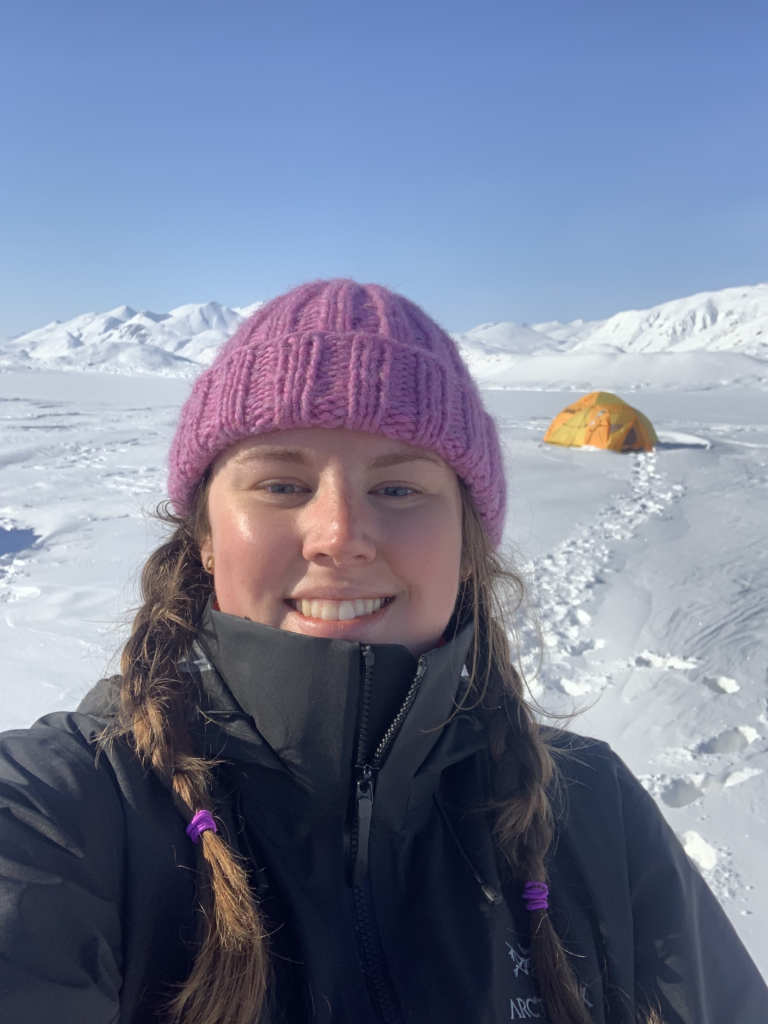
Emma Cameron
Discipline: Arctic Paleolimnology
Age: 25
Nationality: Canada
Organisation: Université Laval (Canada)
Regional focus: Arctic
Social media: Instagram and Twitter
What’s the work that you do?
My current work as an M.Sc.student is dedicated to resurrecting archived climate information from lacustrine sediment cores in High Arctic lakes, with the aim of gaining a clearer understanding of climate change impacts. Due to the logistical challenges of conducting fieldwork in the remote regions of Canada’s Arctic Archipelago, uncertainties persist regarding the response of these sensitive freshwater ecosystems to recent warming. I focus on a select group of lakes near 83°N on Northern Ellesmere Island, Nunavut, analyzing diatoms as bioindicators to better understand the ecological thresholds that exist within these systems.
What keeps you going?
I am continually inspired by the profound sense of exploration and discovery embedded in my research field. Within High Arctic aquatic ecosystems, many questions still persist regarding the biogeochemical mechanisms at play amid the ongoing threat of climate change. I am privileged to collaborate with such a passionate and interdisciplinary scientific community, working to unravel these mysteries. My research takes me to extreme locations on the frontlines of climate change, an opportunity that has cultivated a deep sense of gratitude and responsibility to both understand and advocate for these environments.
What’s your message to the world?
We all share the responsibility to protect vulnerable ecosystems, particularly in the Arctic, where a climate emergency jeopardizes the stability of its once pristine landscapes. Go beyond merely being a spectator to this climate crisis by watching nature documentaries and reading news articles. Engage in researching ways to mitigate anthropogenic warming, whether through scientific inquiry, policy advocacy, or small, everyday individual actions to reduce your ecological footprint. Should you opt for scientific exploration and advocacy, act on your curiosities, seize opportunities that light up your mind and soul, and have confidence in your abilities.
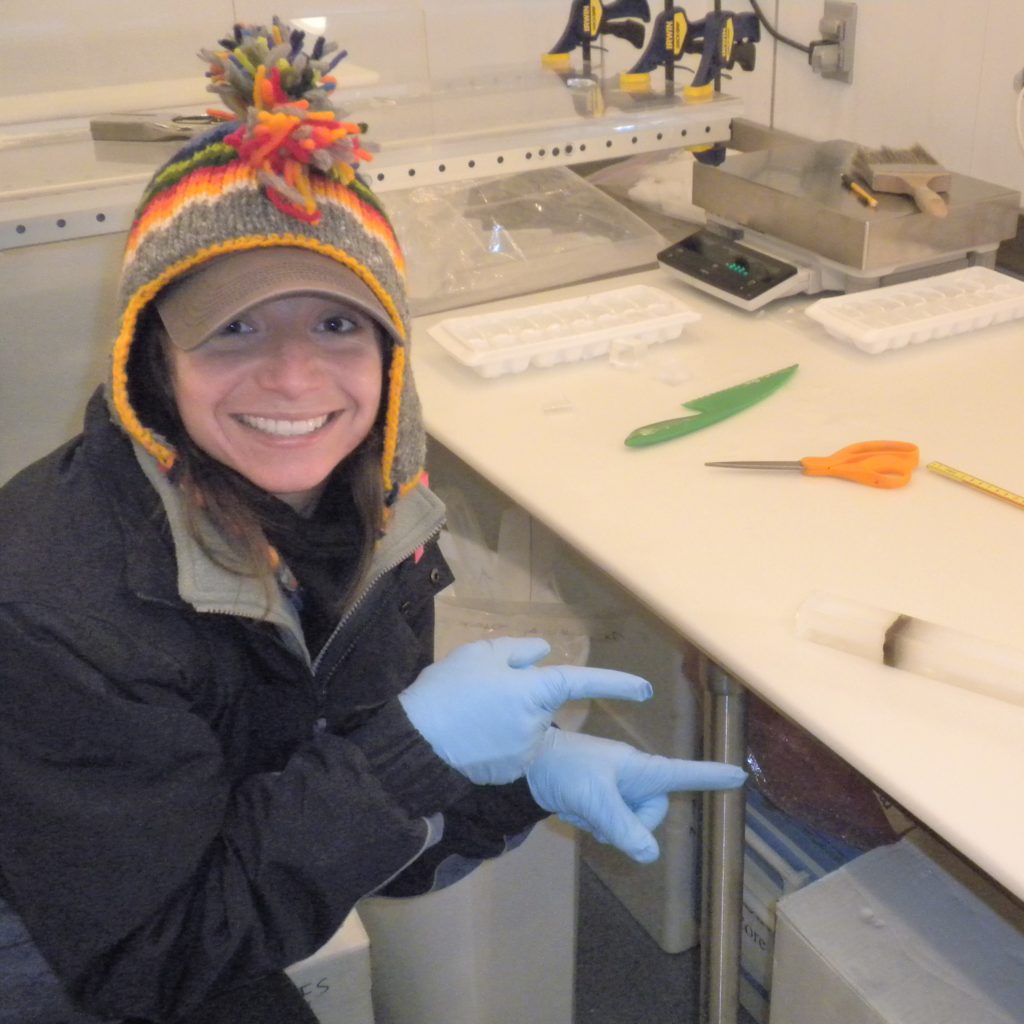
Juliana D’Andrilli, PhD
Discipline: Environmental chemistry
Age: 41
Nationality: USA
Organisation: Louisiana Universities Marine Consortium (USA)
Regional focus: Arctic and Antarctic
Social media: Website and Twitter
What’s the work that you do?
I research carbon cycling from the perspective of dissolved organic matter (DOM) evolution and biogeochemistry in marine, freshwater, terrestrial, and cryosphere ecosystems by investigating its quality and quantity. Aquatic, terrestrial, and icy environments can store and produce microscopic carbon-based materials (DOM). In a warming climate, the release of glacial DOM into surrounding ecosystems is expected to stimulate biotic and abiotic processes, producing greenhouse gases. My goal is to determine the amount and type of carbon-based materials (or chemical energy) stored in glaciers and produced in rivers, soils, and marine waters, to predict its impact in the future.
What keeps you going?
Curiosity led me to learn about the environment. I became a scientist because I am fascinated by the continuing opportunities to learn about the world and communicate my findings. I was encouraged at a young age to pursue an education in scientific disciplines. What was once modeled for me, I strive to give back to the community. As a scientist, I have a responsibility to prepare aspiring scientists with knowledge, reasoning, and communication skills they can use to think critically about the world around them, overcoming challenges and barriers to report their findings effectively, and inspire future generations of students.
What’s your message to the world?
My message to the world is that the more open, curious, and excited you are about learning how the world works through interdisciplinary lenses, the more you will be fascinated. We, as scientists, cannot learn about Earth’s systems with just one lens and our growth as scientists and humans depends on the integration of different perspectives. There is great value in the continual drive to grow as individuals and as a community and when we communicate with each other in an open, curious, and excited manner, we all succeed.
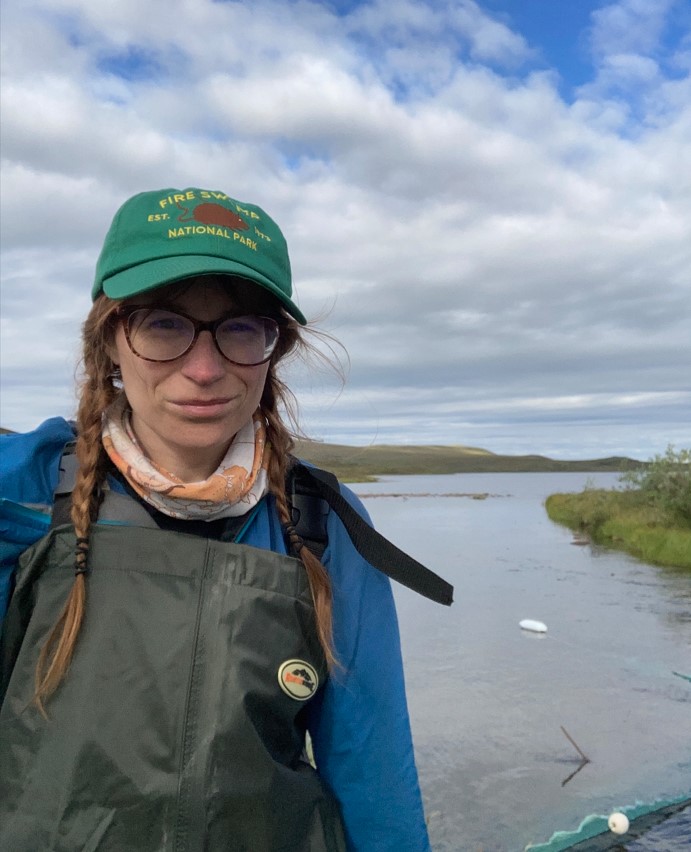
Morag Clinton, PhD, BVMS
Discipline: Aquatic animal health
Age: 32
Nationality: Scotland
Organisation: University of Alaska Fairbanks (USA)
Regional focus: Arctic
Social media: Website and ResearchGate
What’s the work that you do?
In Arctic regions such as Alaska, environmental change is progressing rapidly, with the impacts already seen on important fisheries. As a veterinarian and PhD, my research is focused on the health of aquatic organisms. Through use of molecular techniques and classic pathology, I seek to understand the etiology and consequences of both environmental stressors and infectious disease. Through studying the consequences of disease as well as the factors that can predispose to it, I aim to improve our understanding of impacts of environmental change and disease on animal health.
What keeps you going?
Living in and collaborating in Alaska has given me the opportunity to work with Indigenous groups and villages on projects that aim to answer questions identified as important by communities, for communities. I feel very lucky to have the opportunity to be a part of producing meaningful data that can be used in advocacy or science-based management towards safeguarding animal health. I also love that I have the opportunity to visit places and study aquatic animals that are so important to the people that rely on them, and I strive in all of my projects to find creative, low impact solutions to our monitoring or disease surveillance objectives.
What’s your message to the world?
I believe my work matters not only because the health of animals is key to their survival, but the health of aquatic animals is also so closely linked to environmental and human health. By exploring the impacts of environmental change, disease emergence, and other stressors that can negatively impact aquatic animals, we learn more about what changes the Arctic may need to endure in the future. Fish are critical to many of the ecosystems and communities across Alaska, the place I work and live. I feel very thankful that I can play some small part towards understanding and hopefully safeguarding human, animal and environmental health.
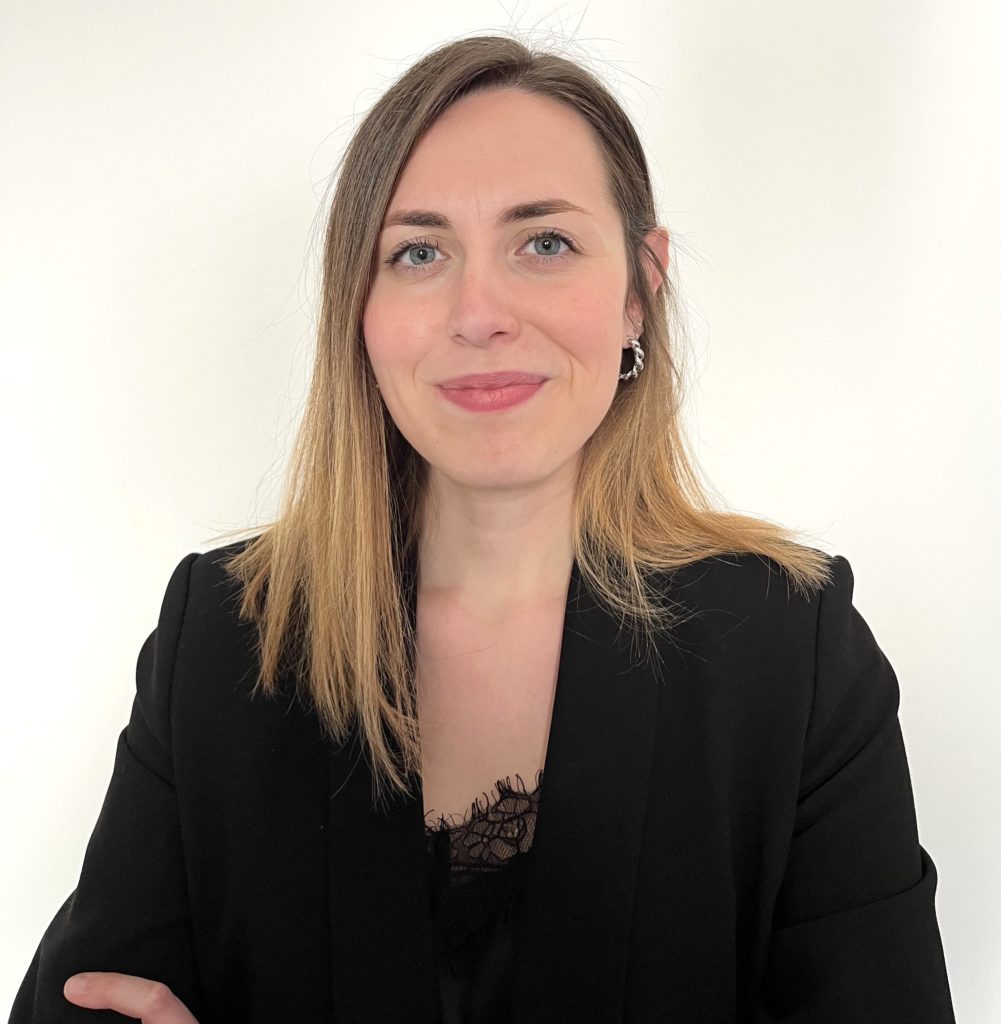
Valentina Cometti, MSc
Discipline: Marine biology
Age: 29
Nationality: Italy
Organisation: University of Genoa (Italy)
Regional focus: Antarctica
Social media: ResearchGate and LinkedIn
What’s the work that you do?
In my master’s, I studied Antarctic benthic sessile community with a particular focus on phylum Bryozoa. I studied marine biodiversity using a particular tool named ARMS (autonomous reef monitoring structures), which was located in Tethys Bay in the Ross Sea. These structures are very important because they are cheap, replicable and usable in any area of the world. They use meta-barcoding techniques to screen for biodiversity and have revealed cryptic and pseudocryptic species.
My study that has two goals: (1) understand the composition and dynamics of benthic sessile communities and (2) provide a database of all samples to make all collected marine biological information available.
What keeps you going?
Antarctic benthic communities change in response to nature or antrhopic impact. Understanding the dynamism and composition of these communities is very important to provide data on climate change. My passion is bryozoans because their structures are perfect and any chemical change alters them. It is an important structured phylum for the benthos, and there is a lot of geological information. Making a baseline of this phylum is crucial to understanding change in a changing world.
What’s your message to the world?
The slow growth of polar benthic organisms helps us compare data about it with other sites around the world. We need to make this information available and share it with other researchers.
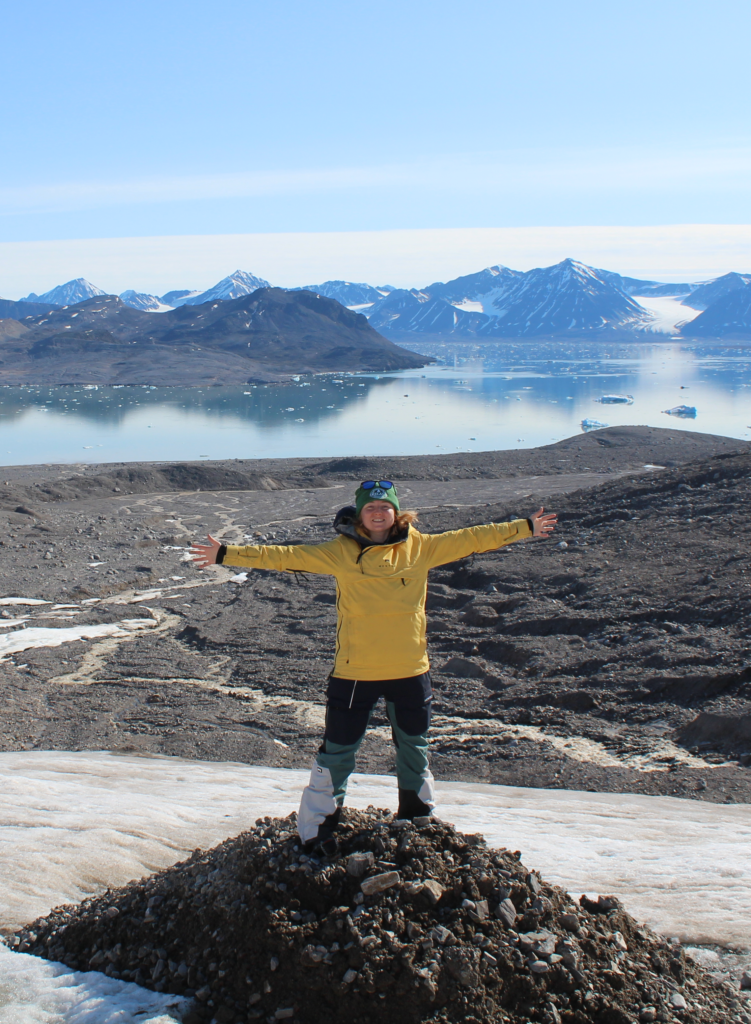
Madeleine Lewis, MSc
Discipline: Polar microbiology
Age: 31
Nationality: UK
Organisation: University of Bristol and British Antarctic Survey (UK)
Regional focus: Arctic and Antarctica
Social media: LinkedIn
What’s the work that you do?
I am researching for my PhD on the micro-environment of snow and ice and the microbial community that inhabits it. I work upon the supraglacial and englacial communities that include algae, bacteria, fungi and viruses, and try to find out what they experience as individual cells living within an ice-crystal matrix. I am specifically interested in the transition from the melting surface of the glacier/icesheet, into the englacial ice we uncover in ice-cores, and how the microorganisms survive this process. I am part of the MicroLab@Bristol research team that specialises in glacial algal blooms and the Ice-core team at the British Antarctic Survey.
What keeps you going?
Spending time in nature, particularly in the mountains, surrounded by snow and ice is one of my greatest joys. I am a very curious person and am often seeking answers as to how and why natures appears as it does – often those answers begin with very small things. I genuinely adore the ability to satisfy my curiosity and find out what is really going on around us in the microscopic world. It is amazing to be able to put something under the microscope and see a tiny, secret universe that you didn’t know existed before.
What’s your message to the world?
I would like to encourage people to take notice of the natural environment around them and be inspired by how nature innovates and collaborates in pursuit of a goal. Nature can be a wonderful teacher and we have so much more to learn about how it works, including our own role within it. Whenever you can, get out there and experience it before it is gone!
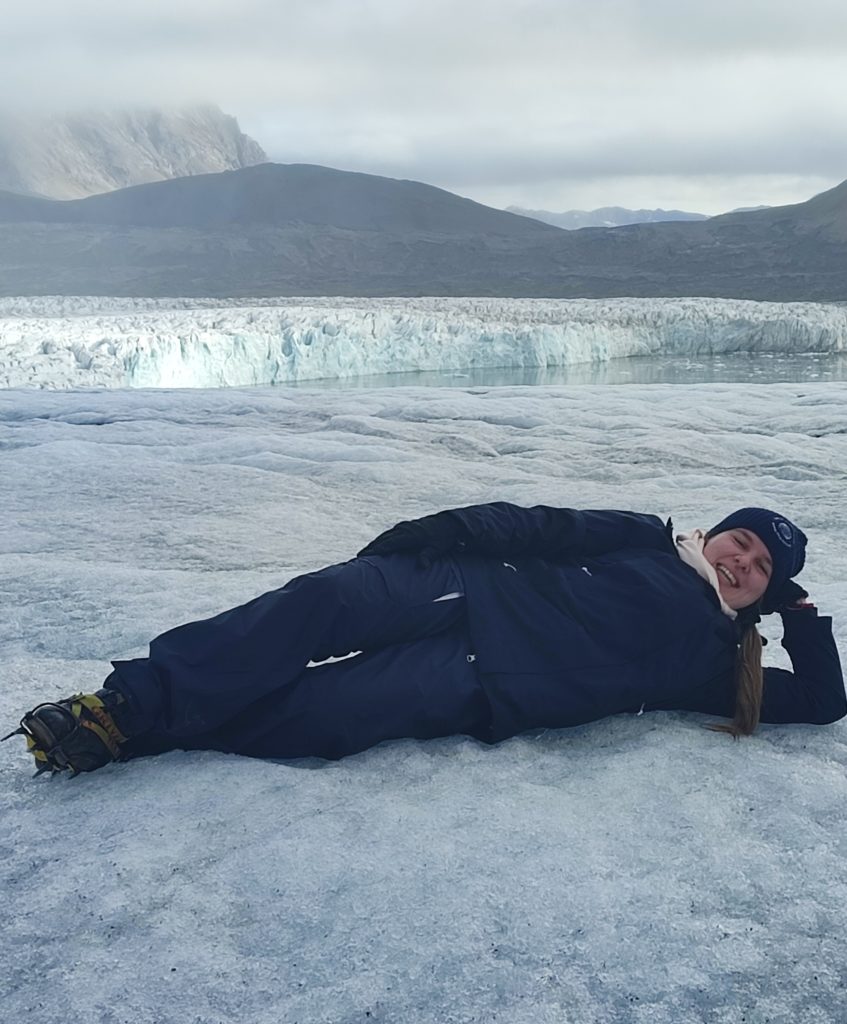
Aleksandra Andrzejowska, MSc
Discipline: Biophysics
Age: 26
Nationality: Poland
Organisation: Jagiellonian University in Cracow (Poland)
Regional focus: Antarctic
Social media: ResearchGate
What’s the work that you do?
I delve into Antarctic lichen’s resilience in extreme conditions, particularly their ability to photosynthesize in sub-zero temperatures. I’m aiming to uncover the underlying molecular mechanisms to this. I am intrigued by their desiccation and resistance to the cold, as these mechanisms appear interconnected. Additionally, I investigate understudied antioxidant substances produced by lichens, particularly under stress. Antarctic lichens are prime candidates for this research. The unique compounds found in them may be of great importance both for scientific research and for the potential use of them in medicine and industry.
What keeps you going?
The coolest thing about working with Antarctic lichens is the opportunity to explore the resilience of life in extreme conditions, contribute to environmental and climate research, and uncover the secrets of these remarkable organisms that often go unnoticed in the natural world. I believe that once you notice lichens, you will be noticing them forever. And with each passing day of getting to know them, they will amaze you even more.
What’s your message to the world?
In the heart of the icy wilderness, I discovered not only the amazing landscapes and unique ecosystems but most of all, I am learning about what is still unknown.
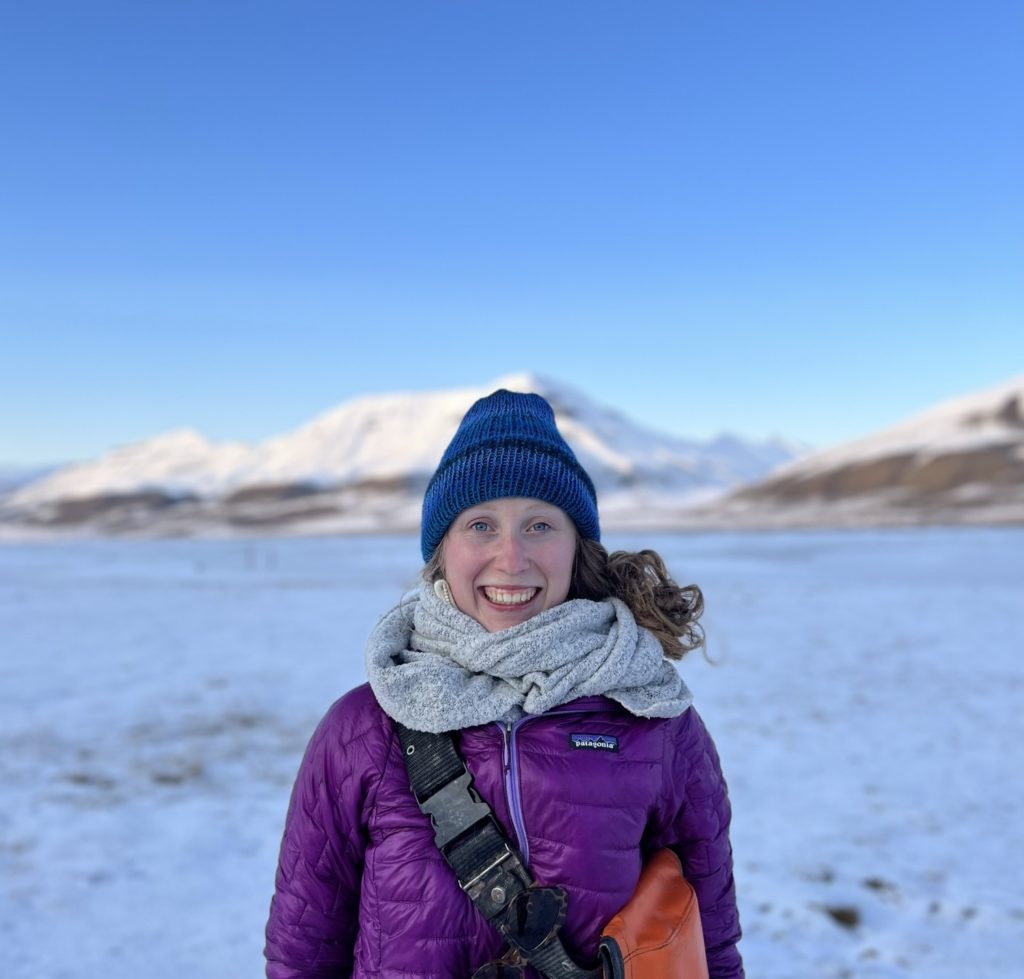
Johanna Sophie Buerkert, LLM
Discipline: International Climate and Environmental Law
Age: 26
Nationality: Germany
Organisation: Centre for International Law and Governance, University of Copenhagen (Denmark)
Regional focus: Arctic
Social media: LinkedIn
What’s the work that you do?
My PhD project focuses on the role that law has in coastal Arctic socio-ecological systems’ resilience to climate change. I take socio-ecological studies on indigenous bowhead whaling in Alaska, Canada and Greenland as a starting point to evaluate the applicable framework of international biodiversity, climate and human rights laws, and the law of the sea. By combining different types of law with socio-ecological studies, my work aims to give an account of the law’s ability to support (or hinder) changes happening on Arctic coastlines due to global warming.
What keeps you going?
Finding moments of meaning. This can happen when I really want to find an answer to something, but also moments where I feel that our research can make an impact. I am passionate about addressing climate change and its effects, and hope that my work will allow me to contribute to this process. Cooperating with others that share an interest in the Arctic gives me a lot of energy and I find it very fulfilling to work across disciplines (e.g. natural science, law, social sciences). Addressing problems together to find the best solutions – that’s what research is (or should be) all about.
What’s your message to the world?
Climate-induced changes are happening and they’re happening fast: it’s an all hands on deck situation, requiring input from all scientific disciplines, lawmaking, policies and an overall societal effort. Contributions look different for everyone, but I hope this encourages you to find where you can make yours. Every effort counts!

Jenny Allen, PhD
Discipline: Marine mammal ecology
Age: 36
Nationality: USA and Australia
Organisation: University of California Santa Cruz (USA)
Regional focus: Antarctica
Social media: Twitter and Instagram
What’s the work that you do?
I am a postdoctoral researcher focused on social learning and culture in cetaceans, specifically the foraging culture of humpback whales. My research looks at how Antarctic humpback whale foraging strategies are learned and spread, as well as what drives them and what they suggest about the changing Antarctic climate.
What keeps you going?
I love using science to expand what we know. When you analyse data, there’s always a brief moment where you know something almost no one else in the world knows. Then you write it up and share it, which means you have helped everyone know a little more about the world than they did before. Field work is also one of my big highlights – I love being on the water and getting to see things that few people have the opportunity to see.
What’s your message to the world?
I hope that as people learn more about the natural world, they will feel more connected to it and fight to protect it. Animal culture, the area that I study, is one of the best ways that I think I can help people to make connections with animal species. We need to foster that connection so that we can work together to push for systemic changes that will preserve unique and vulnerable places like Antarctica.
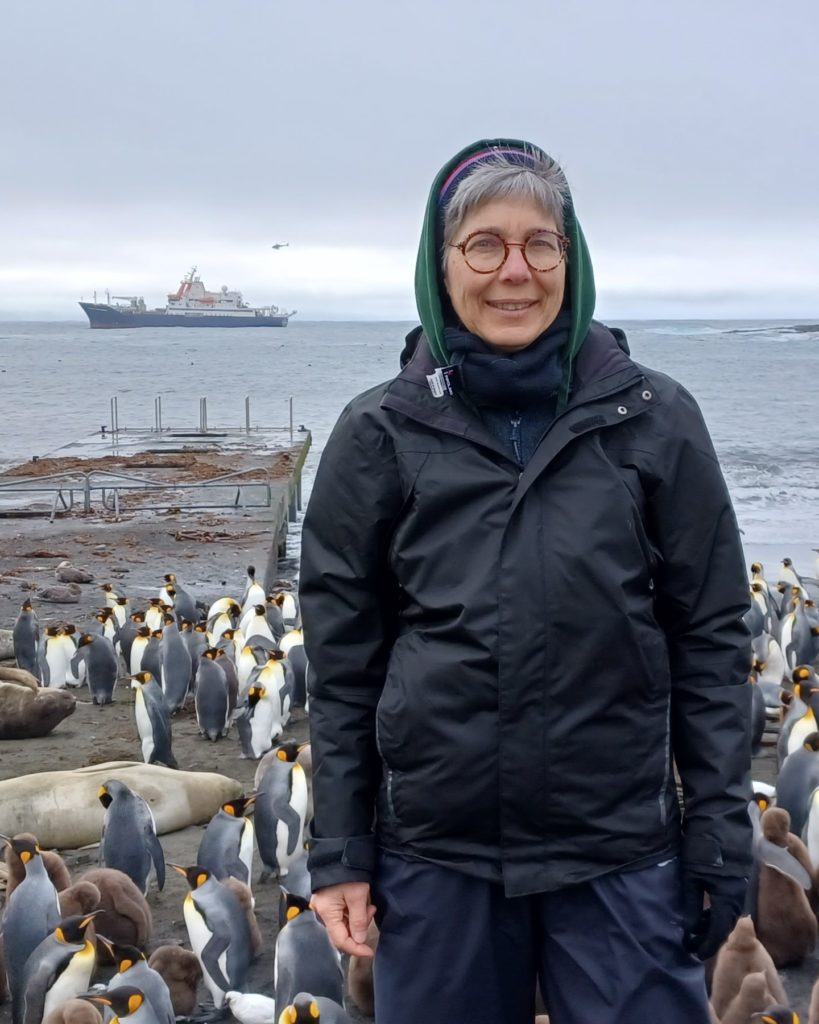
Nathalie Metzler
Discipline: Human & logistic management
Age: 56
Nationality: France
Organisation: French polar institut Paul Emile Victor (France)
Regional focus: Arctic and Antarctic
Social media: ResearchGate and Website
What’s the work that you do?
I lead the French polar institute.
What keeps you going?
The assembly and monitoring of projects as well as the management of large teams have been my daily life on public works subjects: public project management of buildings, ports, airports, roads, maritime safety, drinking water supply, sanitation and management of waste. I know all the facets of this area, among them logistics, unexpected material problems, Health & Safety procedures, human relations and skills management, as well as the administrative, financial and accounting part of public procurement. I appreciate the operational side of teamwork.
What’s your message to the world?
“Each wave knows that it is the sea. What undoes it does not bother it because what breaks it recreates it.”
